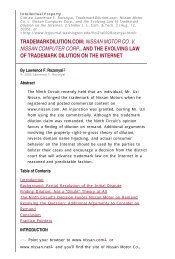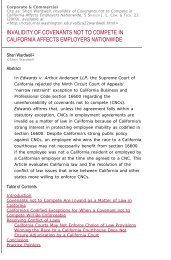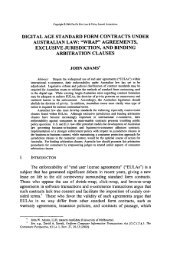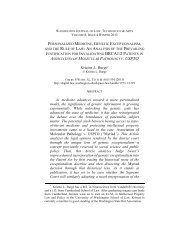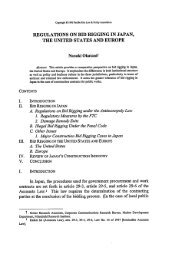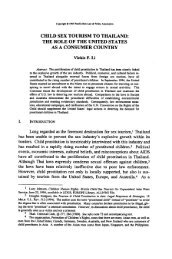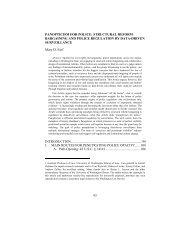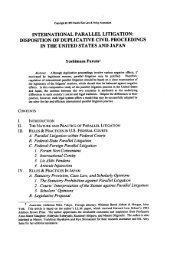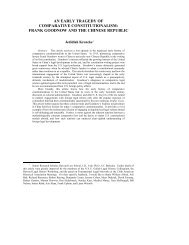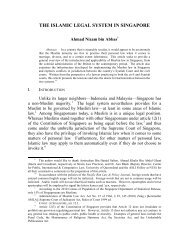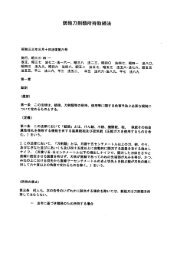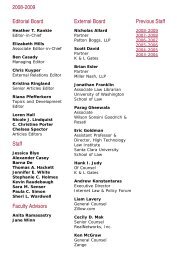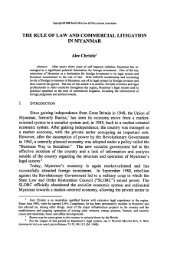Lessons from the Failure of US Apple Exports to Japan
Lessons from the Failure of US Apple Exports to Japan
Lessons from the Failure of US Apple Exports to Japan
You also want an ePaper? Increase the reach of your titles
YUMPU automatically turns print PDFs into web optimized ePapers that Google loves.
Copyright 0 1999 Pacific Rim Law & Policy AssociationCOMPARING APPLES TO ORANGES: LESSONS FROMTHE FAILURE OF U.S. APPLE EXPORTS TO JAPANDustin R. KlingerAbstract: In 1994, <strong>the</strong> United States and <strong>Japan</strong> agreed <strong>to</strong> permit reciprocal freshapple imports after decades <strong>of</strong> negotiations. However, U.S. apple exports <strong>to</strong> <strong>Japan</strong> werea commercial failure. Initial sales peaked in 1995, <strong>the</strong>n quickly declined, and no U.S.apples have been shipped <strong>to</strong> <strong>Japan</strong> since 1997. The United States blames unfairregulations for this failure. This Comment reviews <strong>the</strong> his<strong>to</strong>ry <strong>of</strong> <strong>the</strong> U.S.-<strong>Japan</strong> appledispute, analyzes <strong>Japan</strong>'s apple import regulations, and concludes that those regulationsaggravated, but did not cause <strong>the</strong> commercial failure <strong>of</strong> U.S. apple exports <strong>to</strong> <strong>Japan</strong>.Instead, U.S. apple exports failed because <strong>of</strong> unexpected price competition <strong>from</strong> <strong>Japan</strong>eseapples, insufficient marketing efforts, and consumer rejection <strong>of</strong> <strong>the</strong> only two varietiesregistered for export. Unless <strong>the</strong>se underlying problems are also addressed, efforts <strong>to</strong>reduce <strong>Japan</strong>'s regula<strong>to</strong>ry restrictions on apples will not lead <strong>to</strong> successful exports.I. INTRODUCTIONThe U.S. Government claims that unduly restrictive <strong>Japan</strong>eseregulation caused <strong>the</strong> failure <strong>of</strong> U.S. apple exports <strong>to</strong> <strong>Japan</strong>.' ThisCommnent challenges that claim, and concludes that <strong>the</strong> U.S. apple exportfailure was caused more by fac<strong>to</strong>rs such as <strong>Japan</strong>ese consumer rejection,price competition <strong>from</strong> <strong>Japan</strong>ese apples, and insufficient marketing than byregula<strong>to</strong>ry barriers. The United States has challenged <strong>Japan</strong>'sadministrative exclusion <strong>of</strong> U.S. apples for over twenty years. 2 The appleI U.S. Trade Representative Charlene Barshefsky and Agriculture Secretary Dan Glickman haverepeatedly stated that <strong>Japan</strong>'s quarantine procedures continue <strong>to</strong> unfairly exclude American apples. Theysent <strong>of</strong>ficial demands <strong>to</strong> <strong>the</strong> Minister <strong>of</strong> Agriculture, Forestry and Fisheries as well as <strong>to</strong> <strong>the</strong> Minister <strong>of</strong>International Trade and Industry, for an explanation <strong>of</strong> <strong>the</strong> variety specific quarantine standards whichimpede <strong>the</strong> export <strong>of</strong> U.S. apples <strong>to</strong> <strong>Japan</strong> without resolution. The United States also filed an <strong>of</strong>ficialcomplaint against <strong>Japan</strong> on this matter with <strong>the</strong> World Trade Organization. <strong>US</strong>TR Seeks Comments on<strong>Japan</strong> Food Quarantines, 14 INT'L TRADE REP. 1765 (1997); Tim Shorrock, <strong>US</strong> <strong>to</strong> Investigate <strong>Japan</strong>eseBarriers <strong>to</strong> Fruit Imports: Tokyo's Testing Rules are an Issue for <strong>the</strong> WTO, J. COM., Oct. 17, 1997, at 9A;Biekoku, Kenekisei Kyogi wo Ydkyii [United States Demands Conference on Quarantine Procedures],Kyodo, Oct. 2, 1996; <strong>US</strong> Asks <strong>Japan</strong> for Formal Explanation for Alleged Barriers <strong>to</strong> <strong>Apple</strong> Imports, Int'lTrade Daily (BNA), Oct. 2, 1996; <strong>Japan</strong> Refutes U.S. Complaint on <strong>Apple</strong> Testing, <strong>Japan</strong> Econ. Newswire,Oct. 1, 1996; <strong>Japan</strong>, <strong>US</strong>. Remain Opposite on <strong>Apple</strong> Quarantine, <strong>Japan</strong> Econ. Newswire, June 6, 1997available in LEXIS, Asiapc Library, Allnews file.2 The apple dispute was a low pr<strong>of</strong>ile issue until <strong>the</strong> early 1990s. William DiBenedet<strong>to</strong>, E. coliAno<strong>the</strong>r Worm in <strong>Apple</strong> Talks-Outbreak Could Snarl <strong>US</strong>-<strong>Japan</strong> Negotiations, J. CoM., Nov. 6, 1996, atI A; David Postman, Washing<strong>to</strong>n <strong>to</strong> <strong>Japan</strong>: Buy Our <strong>Apple</strong>s, SEATTLE TIMES, Oct. 3, 1997, at A 1.
PACIFIC RIM LAW & POLICY JOURNALVOL. 8 No. Idispute follows a common pattern <strong>of</strong> U.S. complaints that <strong>Japan</strong>ese policyunfairly prevents U.S. products <strong>from</strong> being sold in <strong>Japan</strong>.'In 1994, <strong>the</strong> United States and <strong>Japan</strong> agreed <strong>to</strong> eliminate apple importprohibitions between <strong>the</strong> two countries ("<strong>Apple</strong> Agreement"). 4 Initial U.S.apple exports <strong>to</strong> <strong>Japan</strong> peaked in 1995, but ended when U.S. apple growersunilaterally quit exporting apples in 1997 because <strong>the</strong>y were frustrated bywhat <strong>the</strong>y considered unfair regula<strong>to</strong>ry requirements. 5This Comment will first review <strong>the</strong> long his<strong>to</strong>ry <strong>of</strong> U.S.-<strong>Japan</strong> appletrade negotiations. It will <strong>the</strong>n analyze <strong>Japan</strong>'s apple regulations before andafter <strong>the</strong> <strong>Apple</strong> Agreement. Comparing <strong>the</strong> affect <strong>of</strong> <strong>Japan</strong>'s apple regulations<strong>to</strong> o<strong>the</strong>r fac<strong>to</strong>rs, this Comment argues that <strong>Japan</strong>ese consumers rejected U.S.apples because <strong>of</strong>: 1) taste and quality, 2) <strong>the</strong> unexpected introduction <strong>of</strong>competitively priced domestic apples, 3) chemical and disease scares, and 4)insufficient commitment and marketing by U.S. apple exporters.This Comment finally predicts that <strong>the</strong> WTO Dispute Panel decisionordering <strong>Japan</strong> <strong>to</strong> end variety-specific testing requirements will eventuallyresult in decreased regulations for agricultural exports <strong>to</strong> <strong>Japan</strong>. However,this decrease in regulations will benefit growers continuing <strong>to</strong> export apples<strong>to</strong> <strong>Japan</strong> more than U.S. growers unless <strong>the</strong> true causes <strong>of</strong> <strong>the</strong> 1995-97 U.S.export failure are addressed.II.BACKGROUNDRelations between <strong>the</strong> United States and <strong>Japan</strong> are primarilyeconomic and <strong>of</strong>ten contentious.' U.S.-<strong>Japan</strong> trade disputes date back <strong>to</strong>1853 when Americans sailed armed ships in<strong>to</strong> <strong>Japan</strong>ese waters <strong>to</strong> demandtrade access. 7 Most trade disputes between <strong>the</strong> countries have been sparkedPaul Blustein, How Do They Like Them <strong>Apple</strong>s: <strong>Japan</strong>ese Consumers Taste <strong>US</strong>.-Grown Fruit,Finally, WASH. POST, Jan. 10, 1995, at DI.4 White House Press Release, Office <strong>of</strong> <strong>the</strong> Press Secretary, President's Statement on Export <strong>of</strong><strong>Apple</strong>s <strong>to</strong> <strong>Japan</strong>, Aug. 23, 1994 (visited Nov. 7, 1998) . The <strong>Apple</strong> Agreement was not a single writtendocument, but a mutual agreement by trade negotia<strong>to</strong>rs <strong>to</strong> make <strong>the</strong> regula<strong>to</strong>ry changes required <strong>to</strong> allowfor <strong>the</strong> reciprocal trade <strong>of</strong> apples within <strong>the</strong> sanitary and plant inspection rules <strong>of</strong> each country. THEAMERICAN CHAMBER OF COMMERCE IN JAPAN, MAKING TRADE TALKS WORK 121 (1997).' Nigel Holloway, Forbidden Fruit, FARE. ECON. REV., Aug. 8, 1996 at 50, available in 1996 WL-FEER 10569567; Brent Evans, Imports <strong>of</strong> <strong>Apple</strong>s <strong>to</strong> <strong>Japan</strong>: Washing<strong>to</strong>n State 's Perspective-Washing<strong>to</strong>n<strong>Apple</strong> Commission Statement, (visited Nov. I, 1998) ; <strong>US</strong>. Ends <strong>Apple</strong> <strong>Exports</strong> <strong>to</strong> <strong>Japan</strong>, Jiji Press Ticker Service, Dec. 24, 1997.6 EDWIN 0. REISCHAUER, THE UNITED STATES AND JAPAN 19, 335-36 (3rd ed. 1965).7 Frank K. Upham, Introduction: Symposium on <strong>the</strong> <strong>US</strong>.-<strong>Japan</strong>ese Trade Relationship, 22
JANUARY 1999<strong>US</strong> APPLE EXPORTS TO JAPANby American demands for market access <strong>to</strong> <strong>Japan</strong>, or by complaints <strong>of</strong>unfair competition <strong>from</strong> <strong>Japan</strong>ese exports. 8 The apple dispute is typical <strong>of</strong><strong>the</strong> market access type <strong>of</strong> dispute where U.S. trade negotia<strong>to</strong>rs push forchanges in <strong>Japan</strong>ese policy <strong>to</strong> facilitate a particular U.S. business interest. 9Trade agreements are regularly negotiated by <strong>the</strong> United States and <strong>Japan</strong> <strong>to</strong>°settle trade disputes, but most are ineffective.'The apple dispute, like most agricultural trade disputes, is fueled asmuch by political as economic interests. 1 " In terms <strong>of</strong> economic value, <strong>the</strong>apple dispute involves an insignificant part <strong>of</strong> <strong>to</strong>tal U.S.-<strong>Japan</strong> trade, 12 but<strong>the</strong> political concerns <strong>of</strong> those who represent apple growers in bothcountries keep <strong>the</strong> issue alive.' 3Since <strong>the</strong> end <strong>of</strong> World War II, both nations have followedagriculture policies seeking <strong>to</strong> protect domestic farmers: <strong>the</strong> U.S. throughexport support and <strong>Japan</strong> through protection <strong>of</strong> farmers <strong>from</strong> outsidecompetition.' 4 These policies have created inherent and ongoing conflict. 5CORNELL INT'L L.J. 375 (1989); REISCHAUER, supra note 6, at 9 (describing U.S. Admiral Ma<strong>the</strong>w Perry's1853 voyage <strong>to</strong> <strong>Japan</strong> with his fleet <strong>of</strong> armored "black ships" and negotiation <strong>of</strong> an agreement <strong>to</strong> open traderelations between <strong>the</strong> U.S. and isolationist <strong>Japan</strong>).8 Upham, supra note 7, at 375.9 Blustein, supra note 3." Of 45 trade pacts studied, only 13 have played significant roles in opening <strong>Japan</strong>ese markets. NanceyDunne, <strong>US</strong>. Trade Deals with <strong>Japan</strong> Often Fail <strong>to</strong> Achieve Aims, FIN. TIMES, Jan. 14, 1997 at 4(l); Only 13 <strong>of</strong> 45Accords with <strong>Japan</strong> Succeeded in Market Access, Business Group Reports, 14 INT'L TRADE REP. 76 (1997)." Agriculture holds symbolic and political importance in international trade far beyond its economicvalue. Micheal R. Reich et al., Agriculture, The Political Economy <strong>of</strong> Structural Change, in AMERICAVERS<strong>US</strong> JAPAN 151, 152-55 (Thomas K. McCraw ed., 1986). Farmers have long been <strong>the</strong> main supportbase for <strong>Japan</strong>'s ruling Liberal Democratic Party. JON WORONOFF, JAPANESE TARGETING 109 (1992)." The <strong>to</strong>tal value <strong>of</strong> U.S. apple sales <strong>to</strong> <strong>Japan</strong> over two years was <strong>US</strong> $17 million compared <strong>to</strong> <strong>US</strong>$200 billion in <strong>to</strong>tal U.S.-<strong>Japan</strong> trade per year. Ambassador Charlene Barshefsky, The Future <strong>of</strong> U.S.-<strong>Japan</strong> Trade Relations, 25 LAW & POL'Y INT'L B<strong>US</strong>. 1287, 1289 (1994); Steve Wilhelm, <strong>Apple</strong> <strong>Exports</strong>Headed for a Record, but <strong>Japan</strong> Sales Lag, PUGET SOUND B<strong>US</strong>. J., Nov. 29, 1996, at 4." John Davies, Foley Presses <strong>Japan</strong>ese <strong>to</strong> Open <strong>to</strong> U.S. <strong>Apple</strong>s, J. COM., June I, 1993, at 4A;Richard L. Holman, <strong>Japan</strong>ese Seek <strong>to</strong> Bar <strong>US</strong>. <strong>Apple</strong>s: Lawsuit by Farmers <strong>to</strong> Block Import <strong>of</strong> American<strong>Apple</strong>s, WALL ST. J., Oct. 27, 1994, at A 17; Beikoku Ringo Yunydi he, Nosuisho ga Kaikin Kettei [MAFFLifts Ban on <strong>US</strong>. <strong>Apple</strong> Imports], Kyodo News Wire, Aug. 20, 1994."4 Both nations' farmers have suffered <strong>from</strong> <strong>the</strong> structural changes <strong>of</strong> industrialization thatuniversally decrease <strong>the</strong> relative share <strong>of</strong> national economic output <strong>from</strong> agricultural production. Reich etal., supra note II at 151. While <strong>to</strong>tal U.S. agricultural exports <strong>to</strong> <strong>Japan</strong> have increased, certain politicallysensitive sec<strong>to</strong>rs such as rice and fruit have been insulated <strong>from</strong> foreign competition. Holloway, supra note5 at 50. Over time, <strong>Japan</strong>'s protected sec<strong>to</strong>rs have fallen fur<strong>the</strong>r behind world efficiency levels and grownmore dependent on government protection <strong>from</strong> outside competition. John 0. Haley, Luck Law, Cultureand Trade. The Intractability <strong>of</strong> United States-<strong>Japan</strong> Trade Conflict, 22 CORNELL INT'L L.J. 403, 405(1989); Woron<strong>of</strong>f, supra note 1I, at I l1." One political commenta<strong>to</strong>r analyzed <strong>the</strong> tension between U.S. agriculture export drives and<strong>Japan</strong>ese protectionism, correctly predicting that <strong>Japan</strong>'s unwillingness <strong>to</strong> permit more Americanagricultural imports would result in fur<strong>the</strong>r deterioration in trade relations. James M. Lyons, <strong>Japan</strong>'s
JANUARY 1999<strong>US</strong> APPLE EXPORTS TO JAPANhalf <strong>the</strong> work force. 21 At <strong>the</strong> same time, <strong>the</strong> expansion <strong>of</strong> large scale U.S.production has increased <strong>the</strong> dependence <strong>of</strong> U.S. farmers, and Washing<strong>to</strong>nState apple growers in particular, on export markets <strong>to</strong> prevent over-supply<strong>from</strong> decreasing prices. 22 These structural fac<strong>to</strong>rs reinforce <strong>the</strong> policytensions underlying <strong>the</strong> U.S.-<strong>Japan</strong> apple dispute.A. His<strong>to</strong>ry <strong>of</strong> <strong>the</strong> <strong>US</strong>.-<strong>Japan</strong> <strong>Apple</strong> DisputeThe U.S.-<strong>Japan</strong> apple dispute is <strong>the</strong> oldest active trade disputebetween <strong>the</strong> two countries, with <strong>of</strong>ficial complaints dating back <strong>to</strong> 1971.23In spite <strong>of</strong> legal provisions allowing imports, U.S. apples were effectivelybanned by <strong>the</strong> Plant Epidemic Prevention Law, which prohibits <strong>the</strong>introduction <strong>of</strong> diseases or insects not <strong>of</strong>ficially, recognized as present in<strong>Japan</strong>. 24 To comply with <strong>the</strong> Plant Epidemic Prevention Law, U.S. appleshad <strong>to</strong> be approved as free <strong>of</strong> disease and pests by <strong>the</strong> Ministry <strong>of</strong>Agriculture, Forestry and Fisheries ("MAFF"). 25 However, <strong>the</strong> standardsand procedures for testing and preventing <strong>the</strong> spread <strong>of</strong> fire blight and <strong>the</strong>codling moth (common in U.S. apples) for MAFF approval are notexpressly defined in <strong>the</strong> Plant Epidemic Prevention Law. 26 MAFF2 Forty thousand large-scale farms in <strong>the</strong> United States grow an average <strong>of</strong> 200 <strong>to</strong> 250 million boxes<strong>of</strong> apples each year. 1995 <strong>US</strong>ITC PUBLICATION No. 2875, INTERNATIONAL TRADE COMMISSION IND<strong>US</strong>TRY& TRADE SUMMARY OF CERTAIN FRESH DECIDUO<strong>US</strong> FRUITS 16 (1995). available in LEXIS 1995 ITCLEXIS 222. Over half <strong>of</strong> U.S. apple production is in Washing<strong>to</strong>n State by 3,800 growers on 73,000hectares (172,000 acres) with 45,000 <strong>to</strong> 50,000 people employed in harvest and packing. WAC Home Page(visited Oct. 19, 1998) < htp://www.bestapples.com/CoreFacts/cf 2.html >. In contrast, 90,000 smallscalegrowers in <strong>Japan</strong> produce only 32 million boxes (899,000 m.t.) <strong>of</strong> apples each year on 47,000hectares. Golden Sour, ECONOMIST, Sept. I1, 1993, at 63; MAFF Homepage (visited Oct. 19, 1998).22 The fall 1998 apple crop faces a price collapse due <strong>to</strong> a record crop, faltering Asian markets, andincreasing low end competition <strong>from</strong> China. Lynda V. Mapes, <strong>Apple</strong> Growers Taking Huge Financial Hit,SEATTLE TIMES, Oct. 11, 1998, at A1; Stephen H. Dunphy, The Newsletter: A Record <strong>Apple</strong> Crop May bein <strong>the</strong> Making, SEATTLE TIMES, May 20 1998, at B 1.23 U.S. Lodges Complaint Against <strong>Japan</strong>'s <strong>Apple</strong> Import Ban, Int'l Trade Daily (BNA), Apr. 8,1993; Blustein supra note 3; DiBenedet<strong>to</strong>, supra note 2.2, Shokubutsu Boeki Ho [Plant Epidemic Prevention Law], Law No. 151 <strong>of</strong> 1950. The banneddiseases include fire blight and <strong>the</strong> codling moth which are found in U.S. apple orchard. See KathrynBarry Stelljes & Dennis Senfi, Fire Blight Control. Nature's Way; Biocontrol <strong>of</strong> Fire Blights, AGRIC. RES.,Jan. 1998. at 14, available in LEXIS, News Library, ASAPII file.25 For fur<strong>the</strong>r discussion <strong>of</strong> MAFF see infra notes 84-89 and accompanying text.26 The requirements for approval were sequentially revealed <strong>to</strong> U.S. negotia<strong>to</strong>rs as each requirementwas fulfilled. In March 1993, before <strong>the</strong> <strong>Apple</strong> Agreement, U.S. Ambassador <strong>to</strong> <strong>Japan</strong> Michael Armacos<strong>to</strong>penly concluded that <strong>the</strong> sequentially increasing MAFF requirements for apples were not based onlegitimate phy<strong>to</strong>sanitary concems, stating, "[C]ontinuation <strong>of</strong> a technical dialogue with <strong>the</strong> Ministry <strong>of</strong>Agriculture has proven <strong>to</strong> be feckless when what we are dealing with in reality is a politically driven nontarifftrade barrier." State Dep't unclassified cable 5105, Mar. 22, 1993, cited in David Johanson &
PACIFIC RIM LAW & POLICY JOURNALVOL. 8 No. Irequested and received various data and information <strong>from</strong> U.S. applegrowers wanting <strong>to</strong> export <strong>to</strong> <strong>Japan</strong> over <strong>the</strong> years, but by not providingfinal inspection procedures, MAFF effectively banned U.S. apples. 27 MAFFresponded <strong>to</strong> U.S. complaints <strong>of</strong> stalling by reaffirming that <strong>Japan</strong>'sstandards and requirements were necessary health protections and thatfur<strong>the</strong>r study was required. 2 "While <strong>the</strong> level <strong>of</strong> <strong>of</strong>ficial attention given <strong>to</strong> <strong>the</strong> apple dispute hasvacillated over time, particularly between U.S. Presidential administrations,<strong>the</strong> Clin<strong>to</strong>n Administration made <strong>the</strong> apple dispute a high priority andincreased pressure on <strong>Japan</strong> <strong>to</strong> end its prohibition on U.S. apples. 2 9Consequently, negotiations continued until August 23, 1994, whenPresident Clin<strong>to</strong>n proudly announced <strong>the</strong> opening <strong>of</strong> <strong>Japan</strong>'s apple market<strong>to</strong> U.S. exports as part <strong>of</strong> a reciprocal agreement eliminating apple importprohibitions between both nations. 3 ' The <strong>Apple</strong> Agreement was hailed acombined diplomatic and business success in "getting <strong>to</strong>ugh" with <strong>Japan</strong>. 3William Bryant, Eliminating Phy<strong>to</strong>sanitary Trade Barriers: The Effects <strong>of</strong> <strong>the</strong> Uruguay Round Agreemen<strong>to</strong>n California Agricultural <strong>Exports</strong>, 6 S.J. AGRI. L. REV. I, 21 (1996).27 Kyodo, supra note 13. U.S. apple growers felt that MAFF was intentionally creating new requestsfor data as a policy <strong>of</strong> delay. Washing<strong>to</strong>n farmers eventually referred <strong>to</strong> MAFF as <strong>the</strong> "bug <strong>of</strong> <strong>the</strong> monthclub." Lori Matsukawa, Washing<strong>to</strong>n State <strong>Apple</strong>s in <strong>Japan</strong>: Communication Plans and Strategies 37 (1996)(unpublished M.A. <strong>the</strong>sis, University <strong>of</strong> Washing<strong>to</strong>n)(on file with <strong>the</strong> University <strong>of</strong> Washing<strong>to</strong>n Library).28 <strong>Japan</strong> Again Refuses Demands <strong>to</strong> Open Market <strong>to</strong> <strong>US</strong>. <strong>Apple</strong>s, Int'l Trade Daily (BNA), Aug. 10, 1993.29 Stephen H. Dunphy, Seattle, <strong>Apple</strong>s at Center Stage in Trade Talks, SEATLE TIMES, Sept. 29,1996, at Fl. The Clin<strong>to</strong>n administration's high level <strong>of</strong> priority on <strong>the</strong> apple issue was illustrated byPresident Clin<strong>to</strong>n handing a basket <strong>of</strong> Washing<strong>to</strong>n apples <strong>to</strong> Prime Minister Hosokawa during a pressconference at <strong>the</strong> Seattle APEC Conference in 1994, and <strong>the</strong> appointment <strong>of</strong> Tom Foley (former Speaker <strong>of</strong><strong>the</strong> United States House <strong>of</strong> Representatives and U.S. Congressman <strong>from</strong> <strong>the</strong> apple growing area <strong>of</strong>Washing<strong>to</strong>n State) as U.S. Ambassador <strong>to</strong> <strong>Japan</strong>. Les Blumenthal, State Businesses Applaud Foley'sAppointment <strong>to</strong> <strong>Japan</strong>, TACOMA NEWS TRIBUNE, Sept. 3, 1997, at D I; Davies, supra note 13; Jim Camden,It's Official, Foley Picked as <strong>Japan</strong> Envoy, SPOKESMAN-REV., Aug. 30, 1997, at Al; see also FoleyPresses <strong>Japan</strong>ese <strong>to</strong> Open <strong>to</strong> U.S. <strong>Apple</strong>s, J. COM., June I, 1993, at 4A.0 Supra note 4.3' The Clin<strong>to</strong>n administration considered <strong>the</strong> <strong>Apple</strong> Agreement a positive example <strong>of</strong> its effective"get <strong>to</strong>ugh" policy <strong>to</strong>wards <strong>Japan</strong>. Paul Blustein, The Boost and Boast <strong>of</strong> Trade Agreements with <strong>Japan</strong>,WASH. POST, Apr. 18, 1996, at D9. Under <strong>the</strong> "get <strong>to</strong>ugh" policy, U.S. negotia<strong>to</strong>rs demanded affirmative<strong>of</strong>ficial <strong>Japan</strong>ese action on specific products and objective result commitments <strong>to</strong> insure <strong>the</strong> introduction <strong>of</strong>U.S. imports, while threatening increased tariffs or prohibition <strong>of</strong> <strong>Japan</strong>ese exports <strong>to</strong> <strong>the</strong> United States if<strong>the</strong> demands were not met. As one former <strong>Japan</strong>ese Trade <strong>of</strong>ficial noted:Once <strong>the</strong> staffing problems were settled, however [<strong>the</strong> Clin<strong>to</strong>n Administration] came at us withsurprising speed and intensity, with both Commerce Secretary Ron Brown and U.S. TradeRepresentative Mickey Kan<strong>to</strong>r demanding hard numbers, targets, market share, indica<strong>to</strong>rs and<strong>the</strong> like. Their demands were so harsh that it was almost as if <strong>the</strong>y didn't recognize <strong>Japan</strong> as asovereign nation...Younosuke Tanaka, Beyond Rhe<strong>to</strong>ric: An In-Depth Look in<strong>to</strong> <strong>the</strong> Core Issues and Causes <strong>of</strong> Strained <strong>US</strong>.-<strong>Japan</strong> relations, BY THE WAY, Sept.-Oct. 1993, at 38 (interviewing former Administrative Vice-Minister <strong>of</strong>
JANUARY 1999<strong>US</strong> APPLE EXPORTS TO JAPAN1. 1994 <strong>Apple</strong> AgreementThe 1994 <strong>Apple</strong> Agreement led <strong>to</strong> a change in <strong>Japan</strong>ese agriculturalimport regulations 3 " and forced MAFF <strong>to</strong> provide <strong>the</strong> necessary inspectionstandards for Red Delicious and Golden Delicious apples imported directly<strong>from</strong> <strong>the</strong> United States. 33 U.S. apple imports are now possible, upon MAFFinspection and approval. 3 " MAFF used <strong>the</strong> information and inspectionreports ga<strong>the</strong>red <strong>from</strong> U.S. growers over <strong>the</strong> years leading up <strong>to</strong> <strong>the</strong> <strong>Apple</strong>Agreement as <strong>the</strong> basic pro<strong>to</strong>col for final inspection and approval. 5 TheMAFF pro<strong>to</strong>col requires: registration <strong>of</strong> orchard areas designated <strong>to</strong> growapples for <strong>Japan</strong>, a 500 meter separation <strong>of</strong> registered apple trees <strong>from</strong> o<strong>the</strong>rrelated fruit trees, direct MAFF <strong>of</strong>ficer inspection <strong>of</strong> <strong>the</strong> designated treesthree times a year, extended cold treatment and fumigation with methylbromide before shipment, and cus<strong>to</strong>ms inspection upon arrival in <strong>Japan</strong>. 362. <strong>Japan</strong>ese <strong>Apple</strong> Growers Protest Against Imported <strong>Apple</strong>sEven with <strong>the</strong> pro<strong>to</strong>col restrictions, <strong>Japan</strong>ese apple growers activelyprotested against <strong>the</strong> <strong>Apple</strong> Agreement, claiming that lower priced foreignapple imports, particularly <strong>from</strong> <strong>the</strong> U.S., were a threat <strong>to</strong> <strong>the</strong>ir continuedexistence and <strong>the</strong>y went so far as <strong>to</strong> file a law suit against MAFF in order <strong>to</strong>block imports. 37 <strong>Japan</strong>ese apple growers actively opposed <strong>the</strong> entry <strong>of</strong>foreign apples, and promoted a message that imported apples endanger <strong>the</strong>health <strong>of</strong> <strong>the</strong> <strong>Japan</strong>ese people and will increase plant disease. 38International Trade and Industry Yuji Tanahashi). The Media aspects <strong>of</strong> U.S. <strong>Apple</strong> exports have beendocumented in great detail. Matsukawa, supra note 27. <strong>Apple</strong> industry representatives boasted, "The applegrowers accomplished in 18 months what 23 years <strong>of</strong> trade negotiations failed <strong>to</strong> do." Jeff Bond, Committed<strong>to</strong> <strong>the</strong> Core, WASH. CEO, Aug. 1996, at 36, 37. But see Yoichi Funabashi, A View From Asia (I), FOREIGNPOL'Y, Winter 1997-1998, at 51-54 (criticizing President Clin<strong>to</strong>n for pushing "managed trade" policies)." Kyodo, supra note 13; see also infra notes 98- 83 and accompanying text.3 William DiBenedet<strong>to</strong>, <strong>Apple</strong> Farmers Try, Try Again: Northwest Growers Hope for <strong>Japan</strong>Success, J. COM., Sept. 20, 1996, at 3A.34 Id" Keith Collins, National Agricultural Statistics Service: Agricultural Outlook-April 1998 Part 1,M2 PRESSWIRE, Mar. 26, 1998, at 15.36 Id3' The suit was apparently <strong>to</strong> no avail. Holman, supra note 13."' Id; <strong>Japan</strong>ese <strong>Apple</strong> Growers, Researchers Protest Move <strong>to</strong> Allow <strong>US</strong>. <strong>Apple</strong> Imports, II INTVLTRADE REP. 1104 (1994); <strong>Japan</strong>ese farmers publicized <strong>the</strong> use <strong>of</strong> chemicals and <strong>the</strong> long transport time neededfor imported apples. Yoko Mizui, Samples From <strong>the</strong> Kingdom <strong>of</strong> Fruit, DAILY YOMIURI, Nov. 25, 1995, at 8.
PACIFIC RIM LAW & POLICY JOURNALVOL. 8 No. IB. Foreign <strong>Apple</strong> Sales in <strong>Japan</strong>In January 1995, <strong>the</strong> first U.S. apples were legally imported and soldin <strong>Japan</strong>. 39 Shipments were limited <strong>to</strong> Red and Golden Delicious, becauseU.S. apple growers had originally submitted <strong>the</strong> test data requested byMAFF only for <strong>the</strong>se varieties. 40 Initial sales were encouraging, 4 and bothU.S. government and apple industry <strong>of</strong>ficials predicted sales <strong>of</strong> <strong>US</strong>$60 <strong>to</strong>100 million per year. 42 In reality, sales fell far short <strong>of</strong> those projections,<strong>to</strong>taling <strong>US</strong>$15 million in 1995 and just <strong>US</strong>$1.5 million in 1996. 43 As <strong>of</strong>1997, no U.S. apples were being shipped <strong>to</strong> <strong>Japan</strong> although <strong>the</strong> importpro<strong>to</strong>col remains in effect. 44 U.S. apple growers decided <strong>to</strong> wait fornegotiation <strong>of</strong> fur<strong>the</strong>r liberalization <strong>of</strong> <strong>Japan</strong>ese apple import regulations. 45Ano<strong>the</strong>r reason Washing<strong>to</strong>n apple growers gave up on <strong>the</strong> difficult <strong>Japan</strong>esemarket 46 was <strong>to</strong> take advantage <strong>of</strong> easier sales markets in Mexico andAsia. 47 However, <strong>the</strong>y may again be attracted <strong>to</strong> <strong>the</strong> <strong>Japan</strong>ese market" All <strong>of</strong> <strong>the</strong> approved and exported apples were <strong>from</strong> Washing<strong>to</strong>n State. 1996 U.S. DEP'T. AGRIC.REP: JAPANESE IMPORTS OF HORTICULTURE PRODUCTS FROM THE UNITED STATES NEARLY DOUBLE SINCE1990 - Part 2 [hereinafter 1996 <strong>Japan</strong> Report] available in WESTLAW, WL 11833493.40 U.S. <strong>Apple</strong>s Move Closer <strong>to</strong> Entering <strong>the</strong> <strong>Japan</strong>ese Market: <strong>Japan</strong>ese Quarantine OfficialsRecently Approved 17 <strong>Apple</strong>s Orchards Totaling Approximately 1,200 acres for Shipment <strong>to</strong> <strong>Japan</strong>,WORLD HORTICULTURE TRADE & U.S. EXPORT OPPORTUNITIES, Oct. 1994, available in LEXIS, NewsLibrary, laccgn File, IAC-ACC-No: 5753240. However, some reports indicate that MAFF onlyrequested data on <strong>the</strong> prevailing Red and Golden Delicious varieties and it was, <strong>the</strong>refore, not <strong>the</strong> U.S.growers' choice. Les Blumenthal, APEC: Washing<strong>to</strong>n <strong>Apple</strong>s Face Tough Road in <strong>Japan</strong>, TACOMANEWS TRIBUNE, Nov. 13, 1995, at B5."' The initial consumer interest and demand were so high, that many retailers doubled <strong>the</strong> prices forU.S. apples. Craig Forman, <strong>Japan</strong> Retailers Lift Price <strong>of</strong> <strong>US</strong>. <strong>Apple</strong>s, ASIAN WALL ST. J., Jan. 16, 1995, atA-p16 Col. 3; Steve Wilhelm, <strong>Apple</strong> <strong>Exports</strong> <strong>to</strong> <strong>Japan</strong> Fall Short <strong>of</strong> Goal, PUGET SOUND B<strong>US</strong>. J., Mar. 31-Apr. 6, 1995, at I." Lyndsay Griffiths, Tokyo Trade Barriers Hurt <strong>Japan</strong> Too, Reuter Business Report, Nov. 12, 1993;DiBenedet<strong>to</strong>, supra note 2." Mickey Kan<strong>to</strong>r, Remarks <strong>of</strong> United States Trade Representative Mickey Can<strong>to</strong>r at <strong>the</strong> Center forStrategic and International Studies Brefing: Upcoming Asia Pacific Economic Cooperation Summit inOsaka, Federal News Service, Nov. 9, 1995, available in LEXIS, News Library, Fednew File; DiBenedet<strong>to</strong>supra note 2. In 1995, <strong>Japan</strong>ese cus<strong>to</strong>ms recorded 8,934,896 kilograms (One standard box <strong>of</strong> applesweighs 42 pounds or 20 Kilograms so approximately 490,000 boxes) <strong>of</strong> U.S. apples entering <strong>Japan</strong>. JAPANTARIFF ASSOCIATION, JAPAN EXPORTS & IMPORTS 1995 337 (Commodity No. 0808.10-000)(1995). In1996, only 404,292 kilograms (21,000 boxes) were recorded. JAPAN TARIFF ASSOCIATION, JAPANEXPORTS & IMPORTS 1996 359 (Commodity No. 0808.10-000)(1996). This number conflicts with <strong>the</strong>50,000 boxes <strong>of</strong>ten reported as sold in <strong>Japan</strong> in 1996. See Wilhelm supra note 12; Jiji, supra note 5." Collins supra note 35; Jiji supra note 5; <strong>Japan</strong> <strong>Apple</strong> Market Is Something <strong>of</strong> a Lemon, L.A.TIMES, Aug. 9, 1996, at D7.4 Steve Wilhelm, <strong>Apple</strong> Growers Take <strong>Japan</strong> <strong>to</strong> WTO, PUGET SOUND B<strong>US</strong>. J., Nov. 28, 1997, at 3.4" See Haley, supra note 14, at 421 (pointing out that, "even if <strong>the</strong>re were no barriers <strong>of</strong> any sort <strong>to</strong>entry, it is not at all certain that many U.S. firms would choose <strong>to</strong> enter <strong>Japan</strong>.")." During this same time frame <strong>of</strong> 1995-1996, U.S. apple exports <strong>to</strong> o<strong>the</strong>r countries in Asia and
JANUARY 1999<strong>US</strong> APPLE EXPORTS TO JAPANbecause most o<strong>the</strong>r Asian export markets have collapsed since 1997, priceshave declined, and U.S. apple crops continue <strong>to</strong> set record volumes. 48The export <strong>of</strong> only Red and Golden Delicious proved <strong>to</strong> be a mistakebecause <strong>Japan</strong>ese consumers clearly preferred sweeter varieties with thin,easy-<strong>to</strong>-peel skins over Red and Golden Delicious. 4 9 Restricted <strong>to</strong> those twovarieties, U.S. growers were not able <strong>to</strong> export o<strong>the</strong>r varieties when Red andGolden Delicious sales faltered.O<strong>the</strong>r countries exporting apples <strong>to</strong> <strong>Japan</strong> gained approval formultiple varieties <strong>of</strong> apples and have faired better. Souih Korea has shippeda small number <strong>of</strong> apples for processing <strong>to</strong> <strong>Japan</strong> since 1971, but greatlyincreased shipments after 1994.5o New Zealand was <strong>the</strong> only o<strong>the</strong>r country<strong>to</strong> gain approval and sell foreign apples in <strong>Japan</strong> before <strong>the</strong> U.S., and wassubject <strong>to</strong> similar regula<strong>to</strong>ry requirements as <strong>the</strong> United States." Oneimportant difference between <strong>the</strong> regula<strong>to</strong>ry approval granted <strong>to</strong> NewZealand and that granted <strong>to</strong> <strong>the</strong> U.S., is <strong>the</strong> number <strong>of</strong> varieties included.New Zealand submitted testing data, and was approved for all <strong>of</strong> <strong>the</strong>ir majorapple varieties including Gala, Granny Smith, Fuji, Braeburn, RedDelicious, and Royal Gala. 5 2 When <strong>Japan</strong>ese consumers rejected Red andGolden delicious apples in favor <strong>of</strong> sweeter varieties, New Zealandexporters were able <strong>to</strong> adjust <strong>to</strong> <strong>the</strong> market. 5 3 However, New Zealand'sMexico set record numbers in volume and pr<strong>of</strong>its, so U.S. apple growers had little incentive <strong>to</strong> develop <strong>the</strong>market in <strong>Japan</strong> and instead focused on o<strong>the</strong>r, more pr<strong>of</strong>itable export markets. Wilhelm, supra note 12.Five Asian nations: Taiwan, Thailand, Hong Kong, Indonesia and <strong>the</strong> Philippines each imported onemillion or more boxes <strong>of</strong> U.S. apples compared <strong>to</strong> <strong>Japan</strong>'s 50,000. Id"' Elliot Blair Smith, California Feels Asia's Pain: <strong>Exports</strong> Fall, Tensions Rise as Crisis Waves LashCoast, <strong>US</strong>A TODAY, Feb. 12, 1998, at BI (referring <strong>to</strong> Washing<strong>to</strong>n <strong>Apple</strong> Commission reported showingapple export declines <strong>from</strong> 1997 <strong>to</strong> 1998 as <strong>of</strong> January 31: China -77.5%, Thailand -71.3%, Malaysia -64. 1%,Indonesia -63.6%, Philippines -54%, Singapore -48.5%, Taiwan -17.8%, Hong Kong -14.9%). In addition,Mexico increased <strong>the</strong> tariffon U.S. apples <strong>to</strong> 101% in September <strong>of</strong> 1997 that greatly reduced sales. Lynda V.Mapes, The Polish is Off<strong>the</strong> <strong>Apple</strong>, SEATTLE TIMES, Nov. 2, 1997, at J 1; Mapes, supra note 22." See infra notes 128-130 and accompanying text.'o <strong>Japan</strong>ese Imports <strong>of</strong> U.S. <strong>Apple</strong>s Fall <strong>to</strong> One-Tenth <strong>of</strong> Previous Season's Total, Int'l Trade Daily(BNA), Apr. 25, 1996. Imports <strong>of</strong> Korean Fuji apples surged <strong>from</strong> 7 <strong>to</strong>ns in 1994 <strong>to</strong> 171 <strong>to</strong>ns in 1995.1997 <strong>Japan</strong> Fruit Report, supra note 18." New Zealand first sent small, sweet, thin-skinned Royal Gala apples <strong>from</strong> New Zealand weighingabout two hundred grams, which were about half <strong>the</strong> price <strong>of</strong> domestic <strong>Japan</strong>ese apples. N. Z San RingoJriku, Jiyilka Gosho No Honkaku Yunyd [New Zealand <strong>Apple</strong>s Landing, The First Actual Imports SinceTrade Liberalization], Kyodo, May 17, 1994; Sa<strong>to</strong>shi Isaka. New Zealand Offers Reform <strong>Lessons</strong>:Ambassador Says Countries Can Learn From Each O<strong>the</strong>r, NIKKEI WEEKLY, Nov. 10, 1997, at 20."2 Shokubutsu Boeki Ho Shiko Kisoku [Plant Epidemic Law Enforcement Regulations] NihonGenko Hoki Vol. 45 Section 29 Nogyo [Agriculture] at Table 2 Index No. 224..' See infra notes 127-157 and accompanying text. O<strong>the</strong>r nations including New Zealand, France,and Korea are now exporting small quantities <strong>to</strong> <strong>Japan</strong>. Those current exporters along with China haveexpressed a desire for decreased apple import regulations and increased market access <strong>to</strong> <strong>Japan</strong>. <strong>Japan</strong>, EU
PACIFIC RIM LAW & POLICY JOURNALVOL. 8 No. Isuccess as an exporter <strong>of</strong> apples <strong>to</strong> <strong>Japan</strong>, has not been as strong asanticipated, due in part <strong>to</strong> <strong>the</strong> same market difficulties that defeated U.S.exports. 4 <strong>Apple</strong> growers <strong>from</strong> New Zealand and around <strong>the</strong> world continue<strong>to</strong> lobby for increased access <strong>to</strong> <strong>the</strong> <strong>Japan</strong>ese market, <strong>of</strong>ten parallel <strong>to</strong> andtaking advantage <strong>from</strong> U.S. diplomatic efforts. 5III.REGULATORY ANALYSISTo understand <strong>the</strong> United States' complaint, it is important <strong>to</strong>understand <strong>the</strong> legal meaning <strong>of</strong> regulations in <strong>Japan</strong>. MAFF actedpredictably and in accordance with past practice on <strong>the</strong> apple issue, andboth U.S. trade negotia<strong>to</strong>rs and apple exporters failed <strong>to</strong> anticipate or workthrough <strong>the</strong> regula<strong>to</strong>ry difficulties.A. Transition <strong>from</strong> Prohibition <strong>to</strong> RegulationBefore <strong>the</strong> <strong>Apple</strong> Agreement, <strong>the</strong> United States complained, in effect,about a lack <strong>of</strong> regulations providing for <strong>the</strong> process <strong>of</strong> apple imports. Nowthat specific regulations provide for apple imports, a number <strong>of</strong> generalagricultural regulations also au<strong>to</strong>matically apply. MAFF generalregulations require approval and licensing <strong>from</strong> <strong>the</strong> Minister <strong>of</strong> Agriculturefor <strong>the</strong> sale <strong>of</strong> any agricultural products in <strong>Japan</strong>. 56 This required licensing<strong>of</strong> new agriculture imports in effect increases regula<strong>to</strong>ry control overimported products because no regulation or control was needed when <strong>the</strong>products were prohibited. This kind <strong>of</strong> liberalization <strong>of</strong> market entry withincreased regulation has been termed "re-regulation" as opposed <strong>to</strong>deregulation. 5 7 Re-regulation is partially motivated by bureaucraticinfighting and attempts <strong>to</strong> increase a Ministry's authority. 8 By listing U.S.Agree on Quarantine Rules for Agricultural Produce, DAILY YOMIURI, Aug. 13, 1997, at 14; French<strong>Apple</strong>s Penetrate <strong>Japan</strong>ese Market, AGRI-IND<strong>US</strong>TRY EUROPE, Dec. 19, 1997; Evelyn Iritani, China at <strong>the</strong>Core <strong>of</strong> <strong>US</strong>. <strong>Apple</strong> Grower's Woes, L.A. TIMES, Oct. 19, 1997, at DI."4 <strong>Japan</strong>'s imports <strong>of</strong> New Zealand apples fell <strong>from</strong> 235 <strong>to</strong>ns in 1994 <strong>to</strong> 190 in 1995. <strong>Japan</strong>eseImports <strong>of</strong> U.S. <strong>Apple</strong>s Fall <strong>to</strong> One-Tenth <strong>of</strong> Previous Season's Total, supra note 50; see also 1997 <strong>Japan</strong>Fruit Report, supra note 18."' Barry Kriss<strong>of</strong>f et al., Barriers <strong>to</strong> Trade in Global <strong>Apple</strong> Markets, M2 PRESSWIRE, Aug. 25, 1997,available in LEXIS, Market Library, Iacnws File.56 No-sambutsu Kakaku Antei Ho [Agriculture Production Price Stabilization Law] Law No. 222 <strong>of</strong>1953, art. 8."7 STEVEN K. VOGEL, FREER MARKETS, MORE RULES: REGULATORY REFORM IN ADVANCEDIND<strong>US</strong>TRIAL COUNTRIES 3 (Peter J. Katzenstein ed., 1996).11 Id. at 204.
JANUARY 1999<strong>US</strong> APPLE EXPORTS TO JAPANapple imports as subject <strong>to</strong> approval, MAFF retains discretionary controlover <strong>the</strong> approval process, as opposed <strong>to</strong> certification by objective criteria orstandards. 9 This kind <strong>of</strong> "strategic reinforcement" is a noted pattern in<strong>Japan</strong>ese regula<strong>to</strong>ry reform. 60Attempts at liberalization without re-regulation in order <strong>to</strong> increasecompetition have been short lived in <strong>Japan</strong>, and generally undermined bybureaucratic resistance. 6 " The lack <strong>of</strong> competition in regulated sec<strong>to</strong>rscoupled with <strong>the</strong> added cost <strong>of</strong> complying with <strong>Japan</strong>'s complicated salesregulations are <strong>of</strong>ten blamed for <strong>the</strong> comparatively high retail prices facedby <strong>Japan</strong>ese consumers. 62 U.S. <strong>of</strong>ficials thus argue that trade liberalizationis as much <strong>to</strong> benefit <strong>Japan</strong>ese consumers with lower prices as it is for U.S.exporters, but lower prices are <strong>of</strong>ten lost in increased regulation. 63In <strong>the</strong> case <strong>of</strong> apples, <strong>the</strong> critical mechanism <strong>of</strong> control shifted <strong>from</strong>prohibition, <strong>to</strong> inspection and discretionary approval. Even if <strong>the</strong>inspections are scientifically justified, <strong>the</strong> slow, intentional, and controllingimplementation <strong>of</strong> apple import requirements amounted <strong>to</strong> a controlmechanism for MAFF. 64 In <strong>the</strong> opinion <strong>of</strong> U.S. growers, <strong>the</strong>se actionsdelayed <strong>the</strong> introduction <strong>of</strong> U.S. apples after <strong>the</strong> <strong>Apple</strong> Agreement, avertedsignificant retail price competition, and limited <strong>the</strong> ability <strong>of</strong> export growers<strong>to</strong> quickly introduce new varieties <strong>to</strong> meet consumer demands. 6 ' This kind<strong>of</strong> discretionary control generally follows significant and deliberate delay inlegal reform in <strong>Japan</strong>. 66 The pattern <strong>of</strong> strategic reinforcement wasexemplified when MAFF delayed <strong>the</strong> implementation <strong>of</strong> an importinspection pro<strong>to</strong>col and <strong>the</strong>n helped prepare <strong>Japan</strong>ese apple growers for <strong>the</strong>possible competitive effect <strong>of</strong> less expensive imports. 67I Id.The pattern <strong>of</strong> liberalizing, but strictly regulating, imports is "strategic" because a ministry has notliberalized for <strong>the</strong> sake <strong>of</strong> liberalization, but has selectively introduced competition in specific marketswhile simultaneously ensuring that domestic firms survive and prosper with as little disruption as possible.The term "reinforcement" applies when <strong>the</strong> government has not retreated <strong>from</strong> intervention, but instead hasreorganized its apparatus for intervention by rearranging policies and reinforcing critical mechanisms <strong>of</strong>ministry control. Id. at 207.61 Emily Thor<strong>to</strong>n, Deregulation Dawdle: <strong>Japan</strong>'s Reform Promises Have Produced Little Action,FAR E. ECON. REV., Sept. 29, 1994, at 58.62 Id.63 Barshefsky, supra note 12, at 1289.See VOGEL, supra note 57, at 211.65 Evans, supra note 5.66 VOGEL, supra note 57, at 211.67 American Consulate-Sapporo Telegraph, Aug. 18, 1994, (visited Nov. 7, 1998) . This preparation closely follows documentedaccounts <strong>of</strong> past liberalization practice. VOGEL, supra note 57, at 208.
PACIFIC RIM LAW & POLICY JOURNALVOL. 8 No. IB. Patterns in <strong>Japan</strong>ese Trade Regulation<strong>Japan</strong>ese trade law, structured in large part by <strong>the</strong> Allied Occupationauthority in <strong>Japan</strong> after WWII, allows for bureaucratic regulation andrestriction <strong>of</strong> foreign trade. 68 <strong>Japan</strong>'s bureaucratic structure contributed <strong>to</strong> <strong>the</strong>erection <strong>of</strong> nearly impenetrable barriers against outside competi<strong>to</strong>rs byproviding for broadly defined discretionary authority and an array <strong>of</strong> approvaland licensing powers that remain in place <strong>from</strong> Occupation reforms. 69Many foreign industries have faced significant <strong>of</strong>ficial and structuralimpediments <strong>to</strong> importing and selling goods in <strong>Japan</strong>, but long-termperseverance has <strong>of</strong>ten led <strong>to</strong> market penetration and eventual success. 70However, <strong>the</strong> highest pr<strong>of</strong>ile trade disputes such as au<strong>to</strong>mobiles andelectronics have been "resolved" by voluntary restraints on <strong>Japan</strong>eseexports after U.S. threats <strong>of</strong> retaliation, ra<strong>the</strong>r than by addressing <strong>Japan</strong>'sregula<strong>to</strong>ry barriers <strong>to</strong> U.S. imports. 7 ' Consequently, where a specific U.S.industry's interest is purely in exporting <strong>to</strong> <strong>Japan</strong>, and not limiting <strong>Japan</strong>esecompetition in <strong>the</strong> U.S. market, <strong>the</strong> American negotiating leverage is not aseffective. Even <strong>the</strong> most successful examples <strong>of</strong> U.S. export-oriented tradeagreements for citrus and beef were settled in <strong>the</strong> shadow <strong>of</strong> U.S. threats <strong>to</strong>limit <strong>Japan</strong>ese industrial export access <strong>to</strong> <strong>the</strong> U.S. market. 72Like <strong>the</strong> au<strong>to</strong>mobile, citrus and beef disputes, <strong>the</strong> apple dispute is<strong>of</strong>ten used as a political rallying point in both <strong>the</strong> U.S. and <strong>Japan</strong> because <strong>of</strong><strong>the</strong> heavily symbolic and political nature <strong>of</strong> agricultural trade issues. 73 TheU.S. is stereo-typed as an arrogant bully demanding guaranteed marketshare, while <strong>Japan</strong> is characterized as a cheat, creating any excuse <strong>to</strong> keepits markets closed and internal consumer prices high. 74 However, <strong>the</strong> apple" Haley, supra note 14, at 406.61 Id at411.70 The struggle for success by U.S. businesses facing <strong>Japan</strong>ese regula<strong>to</strong>ry restrictions; includingCoca-Cola, McDonalds, and IBM are well documented. See LOOK JAPAN LTD., TAKING ON JAPAN (1988);KENICHI OMAE, THE BORDERLESS WORLD 9 (1990).7' Haley, supra note 15, at 415, 419-20.72 Jean Heiman Grier, The Use <strong>of</strong> Section 301 <strong>to</strong> Open <strong>Japan</strong>'s Markets <strong>to</strong> Foreign Firms, 17 N.C. J.INT'L L. & COM REG. 1 (1992); see also infra notes 178-183 and accompanying text." Upham, supra note 7, at 375; S. COHEN, UNEASY PARTNERSHIP: COMPETITION AND CONFLICT INU.S.-JAPANESE TRADE RELATIONS 7 (1985); see generally Nightline (ABC television broadcast, Apr. 15,1996)(Transcript # 3886: John Deutsch, Ezra Vogal, George Packard and Yoshi Tsurumi discussadversarial images <strong>of</strong> <strong>Japan</strong> in <strong>the</strong> U.S. media)." Reich et al., supra note I1, at 151; COHEN, supra note 73, at 2; Shotaro Yachi, Beyond TradeFrictions-A New Horizon for U.S.-<strong>Japan</strong> Economic Relations, 22 CORNELL INT'L L.J. 389, 392 (1989).
JANUIARY 1999<strong>US</strong> APPLE EXPORTS TO JAPANdispute is deeply grounded in local interests and is complicated by culturalattitudes <strong>to</strong>wards <strong>the</strong> proper role <strong>of</strong> government in solving agricultural andtrade problems. 75C. Contrasts in <strong>US</strong>. and <strong>Japan</strong>ese Agency FunctionAdministrative agencies in <strong>the</strong> U.S. and <strong>Japan</strong> take substantiallydifferent approaches <strong>to</strong> <strong>the</strong>ir basic functions. 7 6 <strong>Japan</strong>ese bureaucraciescoordinate and manage domestic interests with little direct enforcement orcoercive authority, while U.S. trade and agricultural bureaucracies areexpected <strong>to</strong> respond <strong>to</strong> domestic demands with decisive and legally bindingpolicies and standards.1 7 American negotia<strong>to</strong>rs in <strong>the</strong> apple dispute haveasked <strong>Japan</strong> <strong>to</strong> implement American style binding regulations providing for<strong>the</strong> import <strong>of</strong> apples, while <strong>Japan</strong>ese negotia<strong>to</strong>rs expect <strong>the</strong> American side<strong>to</strong> see how destabilizing such mandates would be for <strong>the</strong>ir dependence on acooperative regula<strong>to</strong>ry structure. 78MAFF is able <strong>to</strong> enforce agricultural regulations through"administrative guidance" (gyosei shido). 79 No penalty is provided for in<strong>the</strong> Plant Epidemic Prevention Law or Regulations if apples were <strong>to</strong> beimported without Ministry <strong>of</strong> Agriculture approval. It is common for<strong>Japan</strong>ese regulations not <strong>to</strong> provide any penalty for violation, because <strong>the</strong>reis no authorization for <strong>the</strong> agency <strong>to</strong> enforce penalties. 80 Administrativebodies in <strong>Japan</strong> gain voluntary cooperation through essentially non-bindingdirections, suggestions, requests, warnings, advice, notices, practicalguidance and o<strong>the</strong>r acts <strong>of</strong>ten without any codified authority or basis <strong>of</strong>enforcement. 8 ' Informality and avoidance <strong>of</strong> objective standards contribute"' Haley, supra note 14, at 404.71 See John 0. Haley, Governance by Negotiations: A Reappraisal <strong>of</strong> Bureaucratic Power in <strong>Japan</strong>,in THE TRADE CRISIS: How WILL JAPAN RESPOND? 177 (Kenneth B. Pyle ed., 1987) [hereinafter Haley,Governance by Negotiation].17 Haley, supra note 14, at 417.7 Id at416.71 Yoriaki Narita, Gyosei Shido [Administrative Guidance], 4 GENDA! Ho [Contemporary Law] 131(1966), reprinted in THE JAPANESE LEGAL SYSTEM 353 (Hideo Tanaka ed. & James L. Anderson trans.,1976). <strong>Japan</strong>'s Administrative Procedures Act, Law No. 88 <strong>of</strong> 1993, defined administrative guidance as,"any act, not being a disposition, such as a direction, recommendation or suggestion by an administrativebody, in order <strong>to</strong> ask for performance or nonperformance by a particular citizen with a view <strong>of</strong> achieving apolicy aim within <strong>the</strong> sphere <strong>of</strong> competence <strong>of</strong> said administrative body." Administrative Procedures Act,Law No. 88 <strong>of</strong> 1993, translated in Lorenz Kdderitzsch, <strong>Japan</strong>'s New Administrative Procedure Law:Reason's for its Enactment and Likely Implications, 24 L. JAPAN 105, 117 (1994).so Haley, Governance by Negotiation, supra note 76, at 18 1.I d.
PACIFIC RIM LAW & POLICY JOURNALVOL. 8 No. I<strong>to</strong> <strong>the</strong> effectiveness <strong>of</strong> administrative guidance. 82 <strong>Apple</strong> importers,wholesalers, and retailers <strong>of</strong> unapproved apples could be subject <strong>to</strong>administrative guidance if <strong>the</strong> MAFF provisions were not followed. 3D. Bureaucratic Competition in <strong>Japan</strong>Internal <strong>Japan</strong>ese bureaucratic competition for influence andauthority may help explain <strong>the</strong> structure <strong>of</strong> agricultural trade regulations asmuch as farmers' interests in avoiding competition. Agricultural importnegotiations in <strong>Japan</strong> are essentially controlled by two ministries, <strong>the</strong>Ministry <strong>of</strong> Agriculture, Forestry and Fisheries ("MAFF"), discussed above,and <strong>the</strong> Ministry <strong>of</strong> International Trade and Industry ("MITI"). MAFFholds a dominant position in negotiations for agricultural imports <strong>to</strong> <strong>Japan</strong>. 4If MAFF were <strong>to</strong> compromise or allow unrestricted imports, it would loseeconomic and political influence over its farming constituents. 8 5MAFF maintains influence and leverage over domestic farmerspartially by protecting <strong>the</strong>m <strong>from</strong> foreign competition. 6 The Ministry'sexpress purpose is <strong>to</strong> promote <strong>the</strong> welfare <strong>of</strong> <strong>Japan</strong>ese farmers and foster <strong>the</strong>production <strong>of</strong> agriculture. 87 Therefore, foreign competition disrupts MAFFauthority <strong>to</strong> manage and promote domestic interests, and is contrary <strong>to</strong> <strong>the</strong>ministry's purpose. 88 On <strong>the</strong> o<strong>the</strong>r hand, discretionary regulations thatallow MAFF <strong>to</strong> control <strong>the</strong> variety, volume, and timing <strong>of</strong> imported applesactually increase MAFF's ability <strong>to</strong> influence farmers and consumers bycontrolling <strong>the</strong> distribution <strong>of</strong> <strong>the</strong> new imports. 8 9MITI traditionally controls foreign trade negotiations outside <strong>of</strong>agriculture. 9 " In contrast <strong>to</strong> MAFF, MITI is more likely <strong>to</strong> endorse <strong>the</strong>32 FRANK K. UPHAM, LAW AND SOCIAL CHANGE IN POSTWAR JAPAN 207 (1987).s3 For example, <strong>the</strong> Agricultural Transport license required by <strong>the</strong> Agriculture Production PriceStabilization Law could be denied. Supra note 56.14 WORNOFF, supra note 11, at 29.85 Id.16 Haley, Governance by Negotiation, supra note 76, at 177." Norinsho Settchi Ho [Ministry <strong>of</strong> Agriculture, Forestry, and Fisheries Establishment Law], LawNo. 153 <strong>of</strong> 1949, art. 3(l). John 0. Haley, <strong>Japan</strong>'s Postwar Civil Service: The Legal Framework, in THEJAPANESE CIVIL SERVICE AND ECONOMIC DEVELOPMENT 75, 85 (Hyung-Ki Kim et al. eds., 1995)." Pr<strong>of</strong>essor Haley notes that <strong>the</strong> <strong>Japan</strong>ese administrative practices <strong>of</strong> persuasion and collectiveagreements with industry are incompatible with U.S.-style manda<strong>to</strong>ry compliance. Haley, Governance byNegotiation, supra note 77, at 190. MAFF's systematic consensual controls would be disrupted by <strong>the</strong>coercive legal regulations that American trade negotia<strong>to</strong>rs seek."' Reich et al., supra note 11, at 184.90 CHALMERS JOHNSON, MITI AND THE JAPANESE MIRACLE 75 (1982).
JANUARY1I999<strong>US</strong> APPLE EXPORTS TO JAPANprinciple <strong>of</strong> liberalized trade and deregulation for <strong>the</strong> benefit <strong>of</strong> <strong>Japan</strong>eseexport industries. 9 This awkward overlap <strong>of</strong> ministerial authority forinternational trade (MITI) and agriculture issues (MAFF) has <strong>of</strong>ten beenexploited by U.S. trade negotia<strong>to</strong>rs who threaten <strong>Japan</strong>ese access <strong>to</strong> U.S.markets for industrial products in order <strong>to</strong> gain concessions in o<strong>the</strong>r sec<strong>to</strong>rssuch as agriculture. 9 " However, when politically expedient, even MITI willprotect an industry <strong>from</strong> foreign competition and forsake <strong>the</strong> free marketideals that generally benefit <strong>Japan</strong>ese industry. 93MAFF responsibility <strong>to</strong> promote and support agriculture in <strong>Japan</strong>inherently weighs against <strong>the</strong> unfettered import <strong>of</strong> agricultural products. 94However, demographics indicate a near term decrease in apple farmers, <strong>the</strong>constituency motivating MAFF resistance <strong>to</strong> imports. 95 Although applefarmers are presently important in politically concentrated rural districts,<strong>the</strong>ir political and economic influence will decrease as <strong>the</strong> number <strong>of</strong> activefarmers continues <strong>to</strong> decline by attrition. 96 In <strong>the</strong> meantime, MAFFcontinues <strong>to</strong> draft regulations that protect <strong>the</strong> dying industry because it ispolitically advantageous <strong>to</strong> support unified farmers against <strong>the</strong> giant threat<strong>of</strong> foreign apples. 97E. <strong>Apple</strong> Import RegulationsAs discussed above, <strong>Japan</strong>ese administrative procedures generally donot parallel U.S. patterns <strong>of</strong> coercive and binding regulation. Therefore, <strong>the</strong>following textual analysis <strong>of</strong> <strong>Japan</strong>ese regulations will not reveal anylegally binding standards or be <strong>of</strong> use in challenging <strong>the</strong> primarilydiscretionary actions <strong>of</strong> MAFF. On <strong>the</strong> o<strong>the</strong>r hand, analysis <strong>of</strong> <strong>the</strong> relevantregulations is useful here for comparing <strong>the</strong> treatment <strong>of</strong> differentagricultural products and <strong>to</strong> track <strong>the</strong> codification <strong>of</strong> <strong>the</strong> <strong>Apple</strong> Agreement.9' WORONOFF, supra note 1I, at 29.9 Reich et al., supra note 11, at 182-83.3. MARK RAMSEYER & FRANCES MCCALL ROSENBLUTH, JAPAN'S POLITICAL MARKETPLACE 121,129-131 (1993) (discussing how <strong>the</strong> Ministry <strong>of</strong> International Trade and Industry drafted numerous anti-trustexemptions for <strong>the</strong> textile industry for political considerations while admitting that <strong>the</strong> industry was doomed).9 MAFF Establishment Law, Law No. 153 <strong>of</strong> 1949; see supra text accompanying note 87.9 One economist noted, "[The agricultural protectionism dispute] will be solved by demographictransition and <strong>the</strong> migration <strong>of</strong> young people <strong>from</strong> rural <strong>to</strong> urban areas. Most farmers <strong>to</strong>day are elderly."LEON HOLLERMAN, JAPAN, DISINCORPORATED, THE ECONOMIC LIBERALIZATION PROCESS 45-46 (1988).96 Official MAFF statistics show that 46% <strong>of</strong> male and 39% <strong>of</strong> female farmers were aged 65 or overin 1995. MAFF, Agriculture in <strong>Japan</strong>: Results <strong>of</strong> <strong>the</strong> 1995 Census <strong>of</strong>Agriculture (visited Nov. 24, 1998).9' RAMSEYER& ROSENBLUTH, supra note 93.
PACIFIC RIM LAW & POLICY JOURNALVOL. 8 No. I1. Text <strong>of</strong> <strong>the</strong> <strong>Japan</strong>ese Regula<strong>to</strong>ry Amendment Authorizing <strong>US</strong>. <strong>Apple</strong>sOn <strong>the</strong> same day that President Clin<strong>to</strong>n announced <strong>the</strong> <strong>Apple</strong>Agreement, MAFF published <strong>the</strong> regula<strong>to</strong>ry amendment that allows U.S.apples in<strong>to</strong> <strong>Japan</strong>. 98 This amendment came in <strong>the</strong> form <strong>of</strong> a MinisterialOrder (Jirei), which added U.S. apples <strong>to</strong> a list <strong>of</strong> agricultural goodsrecognized by <strong>the</strong> MAFF as eligible for approval. The operative part <strong>of</strong> <strong>the</strong>amendment translated in<strong>to</strong> English reads:In Appendix <strong>to</strong> Table 1-4 plant section after "<strong>Apple</strong>s that are inconformity with <strong>the</strong> standard requirements <strong>of</strong> <strong>the</strong> Minister,"add, "and also Red Delicious and Golden Delicious varieties <strong>of</strong>apple originating <strong>from</strong> <strong>the</strong> United States <strong>of</strong> America, withoutpassing through any o<strong>the</strong>r terri<strong>to</strong>ry, in conformity withstandard requirements and approved by <strong>the</strong> Minister. 99With MAFF's addition <strong>of</strong> U.S. apples <strong>to</strong> <strong>the</strong> allowable fruit list, U.S.apples became eligible for exemption <strong>from</strong> <strong>the</strong> Plant Epidemic PreventionLaw, and <strong>the</strong>reby allowable for importation.' 0 Significantly, <strong>the</strong> finalapproval for apples apparently remains at <strong>the</strong> discretion <strong>of</strong> MAFF under thisregulation because <strong>the</strong>y must still be "approved by <strong>the</strong> Minister." This doesnot mean that approval will be granted, only that it will now be considered.This amendment places no limitations on MAFF implementation orinspection procedures, and such a minimalist approach <strong>to</strong> codifying rules isconsistent with <strong>Japan</strong>ese administrative practice.' 0 '" The full text <strong>of</strong> <strong>the</strong> amendment reads:Pursuant <strong>to</strong> <strong>the</strong> Plant Epidemic Prevention Law (Law No. 151 <strong>of</strong> 1950) Article 7 Section 1 PartI, <strong>the</strong> Plant Epidemic Prevention Enforcement Law Regulation is hereby revised in part inaccordance with <strong>the</strong> following. By order <strong>of</strong> Ogawara Taiichiro, Minister <strong>of</strong> Agriculture,Forestry and Agriculture Aug. 22, 1994. A Ministry Order amending <strong>the</strong> Plant EpidemicPrevention Law Enforcement Regulation in part. The Plant Epidemic Prevention LawEnforcement Regulation (1950 MAFF Order 73) is hereby amended in part.Shokubutsu Boeki Ho Shiko Kisoku lchibu Kaisei Suru [Amendment <strong>to</strong> <strong>the</strong> Plant Epidemic LawEnforcement Regulations], No. 1468-2 J6rei [Ministerial Order] Kanp6 [National Regulations] MondayAug. 22, 1994 Ministry <strong>of</strong> Agriculture, Forestry and Fisheries Order No. 53.I d.10' Haley, Governance by Negotiation, supra note 76, at 179.
JANUARY1999<strong>US</strong> APPLE EXPORTS TO JAPAN2. Effects <strong>of</strong> <strong>the</strong> AmendmentWith this amendment, MAFF literally gives itself authority <strong>to</strong> allow<strong>the</strong> importation <strong>of</strong> apples meeting its own approval." 2 In one sense, <strong>the</strong>amendment has no affirmative meaning, because it was promulgated by <strong>the</strong>ministry itself and still requires <strong>the</strong> discretionary approval <strong>of</strong> <strong>the</strong> ministry <strong>to</strong>import <strong>the</strong> apples. °3 This discretion was already generally established by<strong>the</strong> Plant Epidemic Prevention Law. 1 " 4 On <strong>the</strong> o<strong>the</strong>r hand, by listing Redand Golden delicious varieties specifically, it excludes any o<strong>the</strong>r varietieseven <strong>from</strong> consideration for approval.Authorized by <strong>the</strong> Plant Epidemic Prevention Law,' 0 5 <strong>the</strong> thrust <strong>of</strong>Plant Epidemic Law Enforcement Regulations is <strong>to</strong> prohibit any import ordomestic transport <strong>of</strong> plants and agricultural products, with exceptions6listed in separate tables. These regulations also specify <strong>the</strong> pest anddisease screening <strong>to</strong> be performed on imported fruit in order <strong>to</strong> preventinfestation in <strong>Japan</strong>. 0 7 In addition <strong>to</strong> import licensing, <strong>the</strong> regulationrequires an agricultural transport license <strong>to</strong> distribute agricultural products,although <strong>the</strong> criteria for granting such a license again are not included in <strong>the</strong>regulation and are apparently left <strong>to</strong> MAFF discretion.' 0 Notably, Section14 <strong>of</strong> <strong>the</strong> regulation allows for <strong>the</strong> entry <strong>of</strong> seedling plants in<strong>to</strong> <strong>Japan</strong>,including citrus, apples, and pears as long as <strong>the</strong>y are in transit <strong>to</strong> o<strong>the</strong>rcountries, 0 9 indicating less concern with risk <strong>of</strong> disease than domesticcompetition <strong>from</strong> <strong>the</strong> fruit products.In addition, a special 1997 exemption allows sample products fordisplay in museums, display gardens, or public exhibitions.' 0 Thisexemption appears <strong>to</strong> have been created in response <strong>to</strong> an episode in 1993when <strong>the</strong> Washing<strong>to</strong>n <strong>Apple</strong> Commission ("WAC") was denied permission<strong>to</strong> bring in apples for display at a trade show <strong>of</strong> "American Food." Afterbeing denied, WAC staged a table <strong>of</strong> empty boxes labeled "empty promises102 Amendment, supra note 98.103 Id.'0' Shokubutsu Boeki Ho [Plant Epidemic Law], Law No. 551 <strong>of</strong> 1950.05 Id.Plant Epidemic Law Enforcement Regulations, supra note 52, at 2662-2663. These regulationswere first implemented on June 30, 1950, and have been amended nearly every year since. id. at 2662.0.7 Id ch. 2, art. 5-2 (Import Plant Testing).Os Id ch. 4-2, art. 35(3). Certain kinds <strong>of</strong> products are exempt <strong>from</strong> testing, such as dried roots,scent enhancing dried goods (Ukon), dried macadamia nuts, almonds, cashews, cocoa, pepper, pistachios,and Persian walnuts. Id. ch. 2, art. 5(3).9 id. ch. 2, art. 14(3)."O Id. ch. 2, art 6-2(I)
PACIFIC RIM LAW & POLICY JOURNALVOL. 8 No. I= empty boxes" which gained wide spread media attention in <strong>Japan</strong> andembarrassed <strong>of</strong>ficials at MAFF."'The operative sections <strong>of</strong> <strong>the</strong> Plant Epidemic Prevention Regulationswhich affect apple exports are Sections 8 and 9 which outline proceduresfor plant quarantine inspec<strong>to</strong>rs on import, transport and packaging."' IProhibited items, containers, or packaging that are imported in<strong>to</strong> <strong>Japan</strong> musthave certified import approval."' Section 9 incorporates a table (betsuhyoni) in<strong>to</strong> <strong>the</strong> regulation by reference which lists <strong>the</strong> plants or products that areeligible for exemption by country or area." 4 Section 9 is <strong>the</strong> shortestprovision in <strong>the</strong> regulation, but perhaps <strong>the</strong> most important <strong>to</strong> produceimporters because <strong>of</strong> <strong>the</strong> table listing products which MAFF will approvefor importation <strong>to</strong> <strong>Japan</strong>." 5 The exemption table itself is eight pages long,and is structured in two columns and three rows listing <strong>the</strong> allowable origin,plant, and any additional comments." 6The <strong>Apple</strong> Agreement, <strong>the</strong>refore, did create a regula<strong>to</strong>ry change in<strong>Japan</strong> recognizing <strong>the</strong> import <strong>of</strong> Red and Golden Delicious apples, but due<strong>to</strong> <strong>the</strong> nature <strong>of</strong> regula<strong>to</strong>ry function in <strong>Japan</strong>, that change does not eliminatediscretion or create any concrete standards for U.S. growers <strong>to</strong> follow.F. <strong>Japan</strong>ese <strong>Apple</strong>s in <strong>the</strong> United StatesThe o<strong>the</strong>r component <strong>of</strong> <strong>the</strong> <strong>Apple</strong> Agreement, namely <strong>the</strong> import <strong>of</strong><strong>Japan</strong>ese apples <strong>to</strong> <strong>the</strong> U.S., has attracted much less media attention thanU.S. apples in <strong>Japan</strong>." 7 MAFF announced that as <strong>of</strong> August 17, 1994, <strong>the</strong>.. Evans, supra note 5.12 Plant Epidemic Law Enforcement Regulations supra note 52. ch. 2, art. 8'' Id ch. 2, art. 8(I).14 Id. ch. 2, art. 9(1). A curious result <strong>of</strong> this grouping structure is that in sections 1, 2, 4, 5, 6, 7, 13 andAppendix 2, <strong>the</strong> Hawaiian islands <strong>of</strong>ten appear as a country. In section 2, <strong>the</strong> Hawaiian islands are listed in agroup <strong>of</strong> primarily developing countries as eligible <strong>to</strong> send apples <strong>to</strong> <strong>Japan</strong>. This illustrates how <strong>the</strong> text <strong>of</strong> <strong>the</strong>regulation is not operative outside <strong>of</strong> MAFF discretion that alleviates internal inconsistencies in drafting... Id. ch. 2, art. 9"6 The relevant section translated <strong>from</strong> Table 2-2 (emphasis added):Origin: 2) India, Indonesia, Vietnam, Cambodia, Singapore, Sri Lanka, Thailand, Taiwan, PeoplesRepublic <strong>of</strong> China. Pakistan, Bangladesh, East Timor, Philippines, Brunei, Hong Kong, Malaysia,Myanmar, Laos, Papa New Guinea, Hawaiian Islands, MicronesiaPlant: Citrus (varieties defined in section 10), Acerola, Avocado, ... Grapes, Peaches, Plums,Cherry plums, Ran but<strong>to</strong>n, <strong>Apple</strong>s ....Comment:Excluding tangerine varieties..' Three weeks after <strong>the</strong> arrival <strong>of</strong> U.S. apples in <strong>Japan</strong>, fifteen <strong>to</strong>ns <strong>of</strong> Fuji apples <strong>from</strong> Aomoriprefecture in Northwest <strong>Japan</strong> were shipped <strong>to</strong> Los Angeles <strong>to</strong> be marketed as exotic gourmet apples, but noo<strong>the</strong>r <strong>Japan</strong>ese apple sales in <strong>the</strong> U.S. have been reported. First Batch <strong>of</strong> <strong>Japan</strong>ese <strong>Apple</strong>s Leaves for U.S.,
JANUARY 1999<strong>US</strong> A PPLE EXPORTS TO JAPANU.S. had taken administrative action <strong>to</strong> lift <strong>the</strong> ban on importing <strong>Japan</strong>esegrown apples previously prohibited by health regulations.' 18 The U.S. PlantQuarantine Act <strong>of</strong> 1912 authorizes <strong>the</strong> Secretary <strong>of</strong> Agriculture <strong>to</strong> issueregulations restricting <strong>the</strong> import <strong>of</strong> plant products that create a risk <strong>of</strong>injurious plant diseases or insect pests entering <strong>the</strong> United States." 9Regulations relating <strong>to</strong> fruits and vegetables require importers <strong>to</strong> obtainpermission <strong>to</strong> import fresh fruit in<strong>to</strong> <strong>the</strong> United States, and requireinspection at <strong>the</strong> port <strong>of</strong> entry.' 20 If a particular crop in a producer countryis known <strong>to</strong> be infested with pests or disease, <strong>the</strong>n permission for entry isdenied until an acceptable treatment pro<strong>to</strong>col is established and approved by<strong>the</strong> U.S. Department <strong>of</strong> Agriculture.121The U.S. import regulations are structured in much <strong>the</strong> same manner as<strong>the</strong>ir <strong>Japan</strong>ese counterparts.' 22 The fact that <strong>Japan</strong>ese apples could beadministratively approved for import <strong>to</strong> <strong>the</strong> U.S. pursuant <strong>to</strong> <strong>the</strong> <strong>Apple</strong>Agreement illustrates that U.S. apple import regulations are subject <strong>to</strong>political decisions as much as <strong>to</strong> scientific concerns. The U.S. regula<strong>to</strong>ryaction approving <strong>Japan</strong>ese apples closely resembles <strong>Japan</strong>'s in that ostensiblyhealth related regulations were simply changed by political directive. 1 23IV.REASONS WHY U.S. APPLE EXPORTS TO JAPAN FAILEDCommenta<strong>to</strong>rs and industry representatives have <strong>of</strong>fered a number <strong>of</strong>inconclusive explanations for <strong>the</strong> rapid decline in U.S. apple sales in <strong>Japan</strong>after such high expectations.' 24 In brief, <strong>the</strong> answer is consumer rejection;yet why <strong>Japan</strong>ese consumers rejected <strong>the</strong> U.S. apples is not easilyexplained. The most prominent fac<strong>to</strong>rs for <strong>Japan</strong>ese consumer rejection <strong>of</strong>U.S. apples were <strong>the</strong> unsuitable varieties, domestic competition, testing andpro<strong>to</strong>col requirements, chemical and disease scares, and insufficient25marketing. Resolving each <strong>of</strong> <strong>the</strong>se issues, on <strong>to</strong>p <strong>of</strong> increased retailBBC Summary <strong>of</strong> World Broadcasts, Jan. 16, 1995, available in LEXIS, -Asiapc Library, Bbcswb File.'8 Kyodo, supra note 14."9 7 U.S.C.S. §159 (1998).120 7 C.F.R. §319.56 (1998).121 Id122 <strong>Japan</strong>ese Imports <strong>of</strong> U.S. <strong>Apple</strong>s Fall <strong>to</strong> One-Tenth <strong>of</strong> Previous Season's Total, supra note 50.'2 Exec. Order No. 12,778: 7 C.F.R. § 319 (1995); 59 Fed. Reg. 42,153 (1994); 59 Fed. Reg.29,557 (1994).I24 See supra notes 41-44 and accompanying text.125 William DiBenedet<strong>to</strong>, <strong>US</strong> Warns <strong>Japan</strong> <strong>to</strong> Expand <strong>Apple</strong> Menu, WTO Complaint Hinted if<strong>Japan</strong>ese Don't Bite, J. COM., Oct. 2, 1996, at 3A.
PACIFIC RIM LAW & POLICY JOURNALVOL. 8 No. Iprices <strong>of</strong> U.S. goods in <strong>Japan</strong> due <strong>to</strong> devaluation <strong>of</strong> <strong>the</strong> Yen, 26 will be vitalif future export efforts are <strong>to</strong> avoid <strong>the</strong> same fate.A. Unsuitable VarietiesThe clearest fac<strong>to</strong>r for <strong>Japan</strong>ese consumer rejection <strong>of</strong> U.S. apples isthat Red and Golden Delicious apples do not appeal <strong>to</strong> current <strong>Japan</strong>esetastes. 127 Red Delicious apples are also grown in <strong>Japan</strong>, but have steadilydeclined in popularity. 128 This decline indicates that consumers arerejecting all Red Delicious apples, not just imports. The Red and GoldenDelicious are not sweet enough for <strong>Japan</strong>ese consumers.1 29 <strong>Japan</strong>ese peoplehave traditionally peeled and sliced a single apple in<strong>to</strong> sections <strong>to</strong> share as afamily after a meal; slices are <strong>the</strong>n eaten with small forks or <strong>to</strong>othpicks. 3 °This is in stark contrast <strong>to</strong> <strong>the</strong> American and European consumption <strong>of</strong>apples as snack fruit by picking <strong>the</strong>m up and eating <strong>the</strong>m out <strong>of</strong> handwithout peeling.' 3 ' Consumer rejection based on taste is not a negotiablebarrier that <strong>the</strong> <strong>Japan</strong>ese government can be expected <strong>to</strong> remedy.' 32 On <strong>the</strong>o<strong>the</strong>r hand, U.S. growers argue that <strong>the</strong>y need <strong>the</strong> chance <strong>to</strong> import o<strong>the</strong>rvarieties <strong>to</strong> match <strong>Japan</strong>ese consumer tastes. 133After <strong>the</strong> commercial failure <strong>of</strong> <strong>the</strong> small Red and Golden Delicioussnack fruit, Washing<strong>to</strong>n growers now wish <strong>to</strong> sell varieties more acceptable <strong>to</strong>26 Steve Wilhelm, S<strong>of</strong>t Yen, Hard Times, PUGET SOUND Bus. J., Feb. 14, 1997, at I.127 <strong>Japan</strong>ese consumers consistently described <strong>the</strong> U.S. Red and Golden Delicious apples as "sour"and "small." One clever farmer was quoted as saying, "I tasted <strong>the</strong> Red Delicious apples <strong>from</strong> America,but <strong>the</strong>y weren't that delicious." Wudunn, supra note 18; Paul Blustein, <strong>Japan</strong> Tastes U.S. <strong>Apple</strong>s, INTLHERALD TRIBUNE, Jan. 10, 1995, at Finance.2' Domestic growers are rapidly replacing Red Delicious trees with <strong>the</strong> more popular Fuji andJonagold varieties. 1997 DEP'T AGRIC., JAPAN: ANNUAL FY 98 MARKETING PLAN INFORMATION REP. (4),at 3-4 (July 15, 1997), available in WL 12491929 [hereinafter 1998 Marketing Plan]; (listing in a tableentitled <strong>Japan</strong>ese Production <strong>of</strong> <strong>Apple</strong>s by Variety shows that production <strong>of</strong> Red Delicious declined <strong>from</strong>22,900 <strong>to</strong> 18,200 and 15,600 metric <strong>to</strong>ns between 1995, 1996 and 1997; and that Golden Delicious are alsogrown in <strong>Japan</strong>, but only in very minor quantities).129 Michiyo Nakamo<strong>to</strong>, Imported <strong>Apple</strong>s Fail <strong>to</strong> Grab Big Slice <strong>of</strong> <strong>Japan</strong>ese Pie: Worries About FoodPreservatives and Fierce Competition <strong>from</strong> Local Produce Have Taken Much <strong>of</strong> <strong>the</strong> Shine <strong>of</strong>f <strong>US</strong>.Exporter's Hopes, FIN. TIMES, May 16, 1996, at 4; Mark Magnier, <strong>Japan</strong>ese Market Still Strong for <strong>US</strong>.Growers, J. COM., Feb. 26, 1996, at 7A; Blustein supra note 31.30 1998 Marketing Plan, supra note 128; personal observation <strong>of</strong> <strong>the</strong> author while living with a<strong>Japan</strong>ese family <strong>from</strong> 1989-1990."' Id One WAC <strong>of</strong>ficial noted, "Getting people <strong>to</strong> bite in<strong>to</strong> an apple-<strong>the</strong>y just haven't done that."Blumenthal. supra note 40.32 Intractable issues like consumer rejection are not structural impediments that can simply beresolved by <strong>the</strong> <strong>Japan</strong>ese government. Yachi supra note 74, at 396.33 Postman, supra note 2.
JANUARY 1999<strong>US</strong> APPLE EXPORTS TO JAPAN<strong>Japan</strong>ese consumers including Fuji and Gala.' 34 New Zealand's 1994 importapproval included Granny Smith, Braeburn, and Royal Gala apples and wassubject <strong>to</strong> essentially <strong>the</strong> same insect and disease prevention processesrequired for U.S. apples, and <strong>the</strong> U.S. seeks similar approval.' 35 BecauseNew Zealand submitted testing data on multiple varieties for originalapproval, when <strong>Japan</strong>ese consumers rejected <strong>the</strong> Red Delicious apples, more<strong>of</strong> <strong>the</strong> o<strong>the</strong>r varieties were shipped. 36 U.S. growers did not yet growsubstantial amounts <strong>of</strong> <strong>the</strong> non-Delicious varieties when MAFF testing beganin <strong>the</strong> early 1980s, and could not have submitted <strong>the</strong>m <strong>from</strong> <strong>the</strong> beginning. 3 1There is some dispute about whe<strong>the</strong>r or not U.S. apple growers haveconducted and submitted <strong>to</strong> <strong>Japan</strong>ese authorities test data for additionalvarieties after <strong>the</strong> <strong>Apple</strong> Agreement. 3 8B. Chemical and Disease ScaresAn additional high pr<strong>of</strong>ile fac<strong>to</strong>r in <strong>the</strong> <strong>Japan</strong>ese consumer rejection<strong>of</strong> U.S. apples was a public fear <strong>of</strong> harmful chemicals. 139 A trace detection<strong>of</strong> a preservative not approved in <strong>Japan</strong>, Thiabendazole ("TBZ"), led<strong>Japan</strong>ese cus<strong>to</strong>ms <strong>to</strong> temporarily s<strong>to</strong>p unloading <strong>of</strong> U.S. apples in <strong>the</strong>summer <strong>of</strong> 1995, leaving some shipments in port for over a month. 4 ° TheWashing<strong>to</strong>n <strong>Apple</strong> Commission investigated and concluded that <strong>the</strong> source<strong>of</strong> <strong>the</strong> detected preservative was residue <strong>from</strong> <strong>the</strong> rollers at a single packinghouse, which had processed pears preserved with TBZ before packingapples bound for <strong>Japan</strong>.1 4 ' Many retailers refused <strong>to</strong> s<strong>to</strong>ck <strong>the</strong> importedapples even after <strong>the</strong> presence <strong>of</strong> TBZ was explained and cus<strong>to</strong>ms clearednew shipments. 142In November <strong>of</strong> 1996, an E. coli outbreak in Washing<strong>to</strong>n, Oregon,California, and British Columbia was traced back <strong>to</strong> unpasteurized applecider.' 43 This outbreak was eventually attributed <strong>to</strong> contaminants, and not134 Id... Kyodo, supra note 51.131 Isaka, supra note 51.' Interview with Bill Bryant, Bryant Christie Inc., International Affairs Advisor <strong>to</strong> <strong>the</strong> NorthwestFruit Growers Association, in Seattle, Wash. (Oct. 21, 1998).' Id. Cf Hiro Aida, <strong>US</strong>. Criticizes <strong>Japan</strong>ese <strong>Apple</strong> Testing at WTO, <strong>Japan</strong> Econ. News Wire, Oct. 9,1996; see also Farm Minister Defends Testing <strong>of</strong> <strong>US</strong>. <strong>Apple</strong> Imports, JAPAN WEEKLY MONITOR, Oct. 14, 1996.9 Blumenthal, supra note 40.' Evans, supra note 5.141 Id.142 Id14' Federal microbiologists found a "smoking gun" in <strong>the</strong> E. coli disease outbreak: a strain <strong>of</strong> <strong>the</strong>
PACIFIC RIM LAW & POLICY JOURNALVOL. 8 No. Iapples, but <strong>the</strong> news spread quickly <strong>to</strong> <strong>Japan</strong>, where an E. coli epidemic hadalready caused a national panic earlier in 1996.144 Sales <strong>of</strong> U.S. applesdropped sharply after <strong>the</strong> E. coli reports, and <strong>Japan</strong>ese trade negotia<strong>to</strong>rsreferred <strong>to</strong> <strong>the</strong> E. coli outbreak as pro<strong>of</strong> that <strong>Japan</strong> had reason <strong>to</strong> carefullytest every variety <strong>of</strong> apples before allowing <strong>the</strong>m in<strong>to</strong> <strong>Japan</strong>. 145C. Insufficient MarketingAs an attempt <strong>to</strong> create a new market ra<strong>the</strong>r than compete directlywith <strong>the</strong> high-quality <strong>Japan</strong>ese gift apples, U.S. apple marketers decided <strong>to</strong>present smaller apples as "snacks" ra<strong>the</strong>r than challenging <strong>the</strong> <strong>Japan</strong>esetraditional market for gift or luxury apples. 14 6 This approach was in effectan attempt <strong>to</strong> change <strong>Japan</strong>ese eating habits and perception <strong>of</strong> fruit. Thenormal cost <strong>of</strong> a <strong>Japan</strong>ese-grown apple, packaged individually as a gift, isY400 <strong>to</strong> ¥700 or about five <strong>to</strong> six U.S. dollars. 147 The introduc<strong>to</strong>ry price <strong>of</strong>U.S. apples in <strong>Japan</strong> was one-tenth <strong>the</strong> price <strong>of</strong> gift apples, but soonincreased due <strong>to</strong> smaller U.S. harvests and retail mark-ups. 14 The lowerprices attracted first time consumers, but <strong>the</strong> fall in sales shows that veryfew <strong>Japan</strong>ese buyers were repeat cus<strong>to</strong>mers, and very little effort was made<strong>to</strong> promote U.S. apples as anything more than a news item. 149Moreover, <strong>the</strong> commitment <strong>of</strong> U.S. apple exporters <strong>to</strong> establishing along-term presence in <strong>the</strong> <strong>Japan</strong>ese market is questionable because suchlimited resources were allocated <strong>to</strong> marketing. WAC spent a <strong>to</strong>tal <strong>of</strong><strong>US</strong>$100,000 for marketing and promotion <strong>of</strong> U.S. imported apples during<strong>the</strong> initial year <strong>of</strong> 1995, roughly ano<strong>the</strong>r <strong>US</strong>$100,000 in early 1996 but <strong>the</strong>ncanceled its <strong>Japan</strong> marketing budget in February <strong>of</strong> 1996.150 This fundingwas not sufficient for a sustained nation-wide promotion effort, and bringsbacteria in a bottle <strong>of</strong> unpasteurized Odwalla apple juice. Warren King, E. coli Bacteria Found in <strong>Apple</strong>Juice, SEATrLE TIMES, Nov. 5, 1996. at Local News.'" DiBenedet<strong>to</strong>, supra note 2.145 id.146 1998 Marketing Plan, supra note 128; Evans, supra note 5, at Sec. Ill.141 1998 Marketing Plan, supra note 128.'4' Bond, supra note 31."9 DiBenedent<strong>to</strong>, supra note 33; Matsukawa, supra note 27."s This amount could not buy a single nationwide television ad in <strong>Japan</strong>. Most <strong>of</strong> <strong>the</strong> funds went <strong>to</strong><strong>the</strong> advertising firm <strong>of</strong> Hill & Knowl<strong>to</strong>n, <strong>Japan</strong>, for coordinating media coverage <strong>of</strong> U.S. apples as apolitical news s<strong>to</strong>ry, without brand or product marketing. Matsukawa, supra note 27 at 6-10; GrowersScale Back Ads, COLUMBIAN, Feb. 12, 1996, at A ll.
JANUARY1999<strong>US</strong> APPLE EXPORTS TO JAPANin<strong>to</strong> question <strong>the</strong> apple growers' true commitment <strong>to</strong> establishing acontinuing <strong>Japan</strong>ese apple export market.''Although WAC efforts successfully attracted general media coverage<strong>of</strong> <strong>the</strong> apple imports as a news item, <strong>the</strong>re was no sustained marketingpromotion <strong>of</strong> U.S. apples outside <strong>of</strong> gaining media attention as a political ornovelty item.' The small budget is all <strong>the</strong> more questionable consideringthat WAC and its members were granted <strong>US</strong>$4 million dollars in annualcredits for export promotion. 1 3 In contrast <strong>to</strong> <strong>the</strong> failure <strong>of</strong> apple exports,o<strong>the</strong>r U.S. agricultural exports such as oranges and cherries have, after aninitial period <strong>of</strong> adjustment and accommodation, pr<strong>of</strong>itably worked throughregula<strong>to</strong>ry barriers in <strong>Japan</strong>. 5 4 U.S. citrus and cherry growers haveestablished ongoing market success based on substantial marketinginvestments. 5 5 These models <strong>of</strong>fer lessons for future apple export efforts.D. Domestic CompetitionThe snack approach might have been more successful if <strong>the</strong> <strong>Japan</strong>esedomestic growers had not introduced <strong>the</strong>ir own small, less than perfect Fujiand Tsugaru apples that sold for prices similar <strong>to</strong> imported U.S. apples. 5 6At <strong>the</strong> same time, a decrease in <strong>the</strong> value <strong>of</strong> <strong>the</strong> yen made <strong>the</strong> price <strong>of</strong> U.S.apples higher than projected.' 5 U.S. apples were less able <strong>to</strong> compete onprice with <strong>the</strong> smaller, imperfect and low priced <strong>Japan</strong>ese apples that hadpreviously gone <strong>to</strong> processing.' 5 8Although <strong>Japan</strong>ese apple industry and Government <strong>of</strong>ficials claim<strong>the</strong>re was no coordinated effort <strong>to</strong> counter-market <strong>the</strong> smaller <strong>Japan</strong>ese"' DiBenedent<strong>to</strong>, supra note 149.2 Matsukawa, supra note 27." Target Export Assistance/Market Promotion Program credits were annually granted <strong>to</strong> <strong>the</strong> WACfor export promotion by <strong>the</strong> Department <strong>of</strong> Agriculture. INTERNATIONAL TRADE COMMISSION IND<strong>US</strong>TRY &TRADE SUMMARY OF CERTAIN FRESH DECIDUO<strong>US</strong> FRUITS supra note 21, at 21." Dunne, supra note 10.'" Teresa Watanabe, Sunkist Squeezing Out Higher Sales in <strong>Japan</strong>, L.A. TIMES, Mar. 25, 1991, at D3.56 Mizui, supra note 38; Holloway, supra note 5: Evans, supra note 5.157 Craig Foreman, Well, How Do You Like Them <strong>Apple</strong>s? They'll Cost You, WALL ST. J., Jan. 13,1995, at A10."' Wilhelm, supra note 45. U.S. producers now hold nearly 40 percent <strong>of</strong> <strong>the</strong> processed fruit andjuice concentrate market in <strong>Japan</strong>. Americans' success exporting processed apple juice concentrate <strong>to</strong><strong>Japan</strong> displaced <strong>the</strong> smaller, imperfect <strong>Japan</strong>ese apples <strong>from</strong> <strong>the</strong>ir traditional market and createdcompetition for U.S. fresh apple exports. U.S. Dep't Agri., <strong>Japan</strong>'s Imported Fruit Juice Market Thrives:Industry Overview, AGExPORTER, Apr. 1996, at 4. However, a large portion <strong>of</strong> processed apple productexports <strong>from</strong> <strong>the</strong> U.S. <strong>to</strong> <strong>Japan</strong> is <strong>from</strong> <strong>Japan</strong>ese owned processors. Dan Wheat, Glica Must Tighten itsBelt, WENATCHEE WORLD, Mar. 21, 1997, at A4.
PACIFIC RIM LAW & POLICY JOURNALVOL. 8 No. Iapples against U.S. imports, <strong>the</strong> smaller <strong>Japan</strong>ese apples were available inlarge quantities and had not been sold as fresh apples before 1995.59 In onesense, <strong>the</strong> <strong>Japan</strong>ese consumer did benefit temporarily <strong>from</strong> <strong>the</strong> competitiveeffect <strong>of</strong> apple imports, even if <strong>the</strong> U.S. apple growers did not. 60V. APPLES V. ORANGESThe regulations for <strong>the</strong> import <strong>of</strong> citrus fruit in<strong>to</strong> <strong>Japan</strong> are similar <strong>to</strong>apple regulations in that separate processing and pest treatment arerequired, however, <strong>the</strong>re is no regula<strong>to</strong>ry separation <strong>of</strong> oranges byvariety 16 1 The introduction <strong>of</strong> U.S. citrus fruit also went through multiplediplomatic agreements and false starts. 162 In 1978, <strong>Japan</strong> and <strong>the</strong> U.S.agreed <strong>to</strong> a compromise import agreement allowing only "seasonal citrus,"allowing imports while protecting <strong>Japan</strong>ese domestic citrus growers. 163The compromise citrus agreement quickly fell in<strong>to</strong> dispute overcontrasting interpretations <strong>of</strong> quotas and timelines for increasing U.S. citrusexports. 164 <strong>Japan</strong>ese farmers also publicly protested <strong>the</strong> introduction <strong>of</strong>imported citrus. 165 The American side threatened Section 301 sanctions,GATT action, and retalia<strong>to</strong>ry exclusion <strong>of</strong> <strong>Japan</strong>ese au<strong>to</strong>mobiles. 166Citrus promoters made substantial, long-term marketing investmentsin contrast <strong>to</strong> apple marketing.' 67 The Florida and California Orangegrower associations, and Sunkist in particular, spent millions <strong>of</strong> dollars oninitial marketing and product development campaigns after entering <strong>the</strong><strong>Japan</strong>ese market under limited volume quotas, and were later able <strong>to</strong> take astrong market position when restrictions were reduced. 68 U.S. citrus fruitexports now dominate <strong>the</strong> citrus market in <strong>Japan</strong>.' 69The long-term continuing success <strong>of</strong> U.S. citrus after initialregula<strong>to</strong>ry friction indicates <strong>the</strong> value <strong>of</strong> building consumer relations by"s Wudunn, supra note 18.60 1997 <strong>Japan</strong> Annual Fresh Deciduous Fruit Report, supra note 18; <strong>Japan</strong>ese Imports <strong>of</strong> <strong>US</strong>. <strong>Apple</strong>sFall <strong>to</strong> One-Tenth <strong>of</strong> Previous Season's Total, supra note 50.6' 1998 Marketing Plan, supra note 128; see generally, Overview and GATT Panel Report on <strong>the</strong>U.S-<strong>Japan</strong> Beef and Citrus settlement, 27 I.L.M. 1548 (1988).62 Dunne, supra note 10.6 Reich et al., supra note 11, at 173.I Id.65Id at 175.Id; d66 for a discussion <strong>of</strong> Section 301 see supra Section VII A.167 Watanabe, supra note 155.163 Id69 Id; 1996 <strong>Japan</strong> Report, supra note 39.
JANUARY1999<strong>US</strong> APPLE EXPORTS TO JAPANmaintaining market presence, even if it is a limited presence because <strong>of</strong>regula<strong>to</strong>ry restrictions. U.S. apple importers have now damaged <strong>the</strong> image<strong>of</strong> <strong>the</strong>ir product by sending lower quality apples and abruptly pulling out<strong>of</strong> <strong>the</strong> market. 7 ' In contrast, New Zealand has taken an inside approach,advertising nationwide and persevering through initial rejection <strong>of</strong> RedDelicious apples and adapting <strong>to</strong> consumer preferences. 7 ' Citrus is not<strong>the</strong> only example <strong>of</strong> successful perseverance in <strong>Japan</strong>.VI.APPLES V. CHERRIESU.S. cherries, primarily <strong>from</strong> <strong>the</strong> Pacific Northwest, have enjoyedtwenty years <strong>of</strong> successful export <strong>to</strong> <strong>Japan</strong>, with sales <strong>of</strong> over <strong>US</strong> $100million each year.' 72 These exports are regulated under <strong>the</strong> sameregula<strong>to</strong>ry language used for apples.' 73 The import pro<strong>to</strong>col required byMAFF for cherries is similar <strong>to</strong> <strong>the</strong> apple pro<strong>to</strong>col, including initial MAFFon-sight inspection <strong>of</strong> cherries, fumigation, and variety specificdocumentation.' 7 4 The required data on cherry processing is nearly asdetailed as apple testing including 30,000 <strong>to</strong>tal tests.' 75 However, <strong>the</strong>triple inspection <strong>of</strong> apples each season is, more invasive and expensivethan cherry inspections. 7 6 Unlike <strong>the</strong> apple growers, cherry growers havebegrudgingly continued <strong>to</strong> comply with MAFF variety specific requestsand added varieties until almost all major varieties <strong>of</strong> U.S. cherries wereeligible for export <strong>to</strong> <strong>Japan</strong>.177The examples <strong>of</strong> successful citrus and cherry imports indicate thatcumbersome regulation alone is not impeding sales <strong>of</strong> fruit in <strong>Japan</strong>, and"70 Red and Golden Delicious apples are known for low cost and long shelf life, not for quality <strong>of</strong>flavor. Therefore, new varieties such as Fuji are being widely planted and sold in Washing<strong>to</strong>n State andelsewhere in <strong>the</strong> U.S. Rick Steigmeyer, Quality Crusade Caps Fruitful 7 Decades in <strong>Apple</strong> Industry: AuvilHas Led <strong>the</strong> Way Among State's Growers, SEATTLE TIMES, Apr. 18, 1998, at C 1.'7 Isaka. supra note 51.72 1996 <strong>Japan</strong> Report, supra note 39; JAPAN TARIFF ASSOCIATION, supra note 43 (Commodity No.0809.20-000).' The regulation for cherries reads: "Imported Garnet, Tulare, Bing, Brooks, Lambart, and Rainiervarieties <strong>of</strong> cherries originating in <strong>the</strong> United States <strong>of</strong> America without passing through any o<strong>the</strong>r terri<strong>to</strong>ryin conformity with <strong>the</strong> standards and approved by <strong>the</strong> Minister [are allowed]." Plant Epidemic PreventionLaw, Law No. 151 <strong>of</strong> 1951, Attachment 19 <strong>to</strong> Table 2." Matsukawa, supra note 27, at 35. Ironically, many <strong>of</strong> <strong>the</strong> cherry growers involved in <strong>the</strong> extendednegotiations with MAFF in 1978 for cherries also grow apples. Id The cherry growers, while generallysuccessful, also object <strong>to</strong> <strong>the</strong> difficult process <strong>of</strong> adding new varieties.175 Id.7 Bryant, supra note 137.'7 Id; Matsukawa, supra note 27, at 35-37.
PACIFIC RIM LAW & POLICY JOURNALVOL. 8 No. Ithat with persistence and consumer acceptance <strong>the</strong> current regulations dopermit importation. Even <strong>the</strong> successful cherry exporters are seeking lessrestrictive processes <strong>to</strong> add new varieties, but have continued <strong>to</strong> sell in<strong>Japan</strong> while working for change. 7 8VII.REEMERGENCE OF THE APPLE DISPUTEThe failure <strong>of</strong> U.S. apple sales after 1996 ignited new complaintsagainst <strong>Japan</strong> and opened a new chapter in <strong>the</strong> apple dispute. 7 9 U.S.<strong>of</strong>ficials argued that <strong>the</strong> <strong>Apple</strong> Agreement should include o<strong>the</strong>r varietiessuch as Gala, Fuji, Braeburn, Granny Smith and Jonagold in <strong>the</strong> Red andGolden Delicious pro<strong>to</strong>col already in place. 8 ' MAFF rejected that position,noting that data cannot be applied <strong>to</strong> o<strong>the</strong>r varieties indiscriminately.' 81 TheU.S. contends that MAFF is inhibiting apple imports by requiring lengthyand redundant testing on each new variety <strong>to</strong> be introduced.' 82 Testing for<strong>the</strong> Red and Golden Delicious varieties <strong>to</strong>ok seven years <strong>to</strong> satisfy MAFF,and <strong>the</strong> Washing<strong>to</strong>n apple growers and scientists insist that codling mothtreatment is in no way affected by variety <strong>of</strong> apple. 1 83 MAFF in tumcontends that o<strong>the</strong>r varieties are welcome if <strong>the</strong> tests show that <strong>the</strong> treatmentprocess is effective.' 84MAFF requirements include: inspections, separate growing areas,separate processing, and additional fumigation <strong>of</strong> apples <strong>to</strong> be sent <strong>to</strong><strong>Japan</strong>. All <strong>of</strong>f <strong>the</strong>se requirements are at <strong>the</strong> exporting growers' expense.' 85U.S. growers initially unders<strong>to</strong>od and agreed with <strong>the</strong> <strong>Japan</strong>ese desire <strong>to</strong>'7' Shorrock, supra note I; Bryant, supra note 137.'7 Shorrock, supra note I.SQ Toshio Aritake, <strong>US</strong>.-<strong>Japan</strong> <strong>Apple</strong> Talks Fail: <strong>US</strong>. May Appeal <strong>to</strong> WTO, Int'l Trade Daily (BNA),Mar. 11, 1997."' <strong>Japan</strong>, <strong>US</strong>. Remain Opposite on <strong>Apple</strong> Quarantine, supra note I; Farm Minister Defends Testing<strong>of</strong> U.S. <strong>Apple</strong> Imports, JAPAN WEEKLY MONITOR, Oct. 14, 1996." <strong>US</strong>TR Ambassador Ira Shapiro is quoted as saying, "We have broken through after 23 years <strong>of</strong>getting U.S. apples in<strong>to</strong> <strong>Japan</strong> only <strong>to</strong> discover that <strong>the</strong>n <strong>the</strong>re were requirements being put on a variety-byvarietybasis which were inhibiting our exports." Shapiro Reiterates WTO Action on <strong>Apple</strong>s, Jiji PressTicker Service, Mar. 6, 1997."8 Evans, supra note 5; Matsukawa, supra note 27, at 36-38.'s John Zarocostas, <strong>Japan</strong>-<strong>US</strong> <strong>Apple</strong> Talks Still Bearing No Fruit, J. COM., June 9, 1997, at 2A.... The fumigation process requires <strong>the</strong> use <strong>of</strong> methyl bromide, a harsh but effective fumigation agentthat will be banned in <strong>the</strong> United States after 2001 under <strong>the</strong> Clean Air Act. 40 CFR § 82 (1990);Protection <strong>of</strong> Stra<strong>to</strong>spheric Ozone, 63 Fed. Reg. 9151 (1998). Therefore, after 2001, it will becomeimpossible for U.S. growers <strong>to</strong> comply with <strong>the</strong> current pro<strong>to</strong>col. Patricia B. Demetrio, Unfair <strong>to</strong> <strong>US</strong>.Farms, J. COM., Oct. 21, 1997, at IB; Holloway, supra note 5; Evans, supra note 5. Cf <strong>Japan</strong>, EU Agreeon Quarantine Rules for Agricultural Produce, supra note 53 (discussing <strong>Japan</strong>'s agreement <strong>to</strong> split <strong>the</strong>quarantine costs <strong>of</strong> additional inspections with EU exporters due <strong>to</strong> environmental compliance).
JANUARY 1999<strong>US</strong> APPLE EXPORTS TO JAPANavoid disease and pests, but now <strong>the</strong> growers object <strong>to</strong> <strong>the</strong> <strong>Japan</strong>eseposition that <strong>the</strong> same procedures must be separately tested and confirmedon each variety. 8 6 According <strong>to</strong> U.S. apple industry <strong>of</strong>ficials, <strong>the</strong> variety<strong>of</strong> <strong>the</strong> apple does not alter <strong>the</strong> effect <strong>of</strong> <strong>the</strong> external disease and pestcontrol measures, so variety specific testing is not scientifically valid. 18 7There is also evidence that a strain <strong>of</strong> fire blight may already exist in<strong>Japan</strong>, thus negating <strong>the</strong> reason for <strong>the</strong> multiple inspection and separategrowing areas for U.S. apples. 8 <strong>Japan</strong>ese <strong>of</strong>ficials strongly deny that fireblight exists in <strong>Japan</strong>. 8 9After failing <strong>to</strong> gain MAFF inclusion for o<strong>the</strong>r varieties under <strong>the</strong><strong>Apple</strong> Agreement, <strong>the</strong> U.S. <strong>to</strong>ok unilateral action <strong>to</strong> attack <strong>Japan</strong>'s appleimport requirements with a Section 301 investigation and filed aneventually successful complaint with <strong>the</strong> World Trade Organization("WTO").' 90 Since <strong>the</strong>n, direct U.S.-<strong>Japan</strong> trade talks have faltered. 1Although Red and Golden Delicious apples are approved, MAFF will notapply <strong>the</strong> data or fumigation processes used in <strong>the</strong> initial approval fordifferent varieties <strong>from</strong> <strong>the</strong> U.S. and insists that each variety must be testedseparately.' 92 This variety specific testing requirement was <strong>the</strong> basic issue<strong>of</strong> <strong>the</strong> parallel domestic Section 301 investigation and WTO dispute. 93s6 Interview with Pr<strong>of</strong>. Dan F. Henderson, <strong>Japan</strong>ese Law Scholar, and Washing<strong>to</strong>n State applegrower, in Seattle Wash. (Jan. 5, 1998)." According <strong>to</strong> Hugh W. Ewart, Vice-President <strong>of</strong> <strong>the</strong> Northwest Horticulture Council, "The scienceis very strong in saying <strong>the</strong>re doesn't need <strong>to</strong> be additional testing." DiBenedet<strong>to</strong>, supra note 2."' A controversial <strong>Japan</strong>ese researcher, Akio Tanii, committed suicide after being criticized forpublishing research on a disease similar <strong>to</strong> fire blight (Erwina amylovora) in <strong>Japan</strong>. Leslie Helm & GaleEisens<strong>to</strong>dt, <strong>Japan</strong>ese Researcher's Suicide Leads <strong>to</strong> Claims <strong>of</strong> a Cover-Up, SEATTLE TIMES, June 23,1996,at FI. The <strong>Japan</strong>ese government insists that <strong>the</strong> precautions are necessary and that <strong>the</strong> <strong>Japan</strong>ese fire blightis an isolated, less harmful strain not affecting apples."' Hidemi Taguchi, <strong>Japan</strong>: 'Cover-Up' Article Paints Misleading Picture <strong>of</strong> <strong>Japan</strong>, SEATrLE TIMES,.Aug. 30, 1996, at B7 (expressing <strong>the</strong> Seattle Consular General <strong>of</strong> <strong>Japan</strong>'s disagreement with <strong>the</strong> Helm &Eisens<strong>to</strong>dt article; referring <strong>to</strong> <strong>the</strong> <strong>Japan</strong>ese infection as "shoot blight <strong>of</strong> pear;" following verbatim withletters which appeared in many newspapers across America signed by various Consular Generals.). CornellUniversity researcher Steven Beer, who worked with Tanii, states that <strong>the</strong> disease is in fact a strain <strong>of</strong> fireblight. Holloway, supra note 5."9 Initiation <strong>of</strong> Section 302 Investigation and Request for Public Comment: <strong>Japan</strong> Market AccessBarriers <strong>to</strong> Agriculture Products, 62 Fed. Reg. 53,853, Oct. 16, 1997; WTO Dispute Settlement ProceedingRegarding Varietal Testing and Quarantine Requirements, 62 Fed. Reg. 53,378, Oct. 14, 1997; <strong>Japan</strong>Market Access Barriers <strong>to</strong> Agricultural Products, WTO Dispute No. 301-112 released Oct. 27, 1998,Complaint by <strong>the</strong> United States WT/DS76R [hereinafter Panel Decision]; affirmed by <strong>Japan</strong>-MeasuresAffecting Agricultural Products WT/DS76/AB/R, Feb. 22, 1999, [hereinafter Appellate Decision].191 Zarocostas, supra note 184.192 d.193 Ono, supra note 28. <strong>US</strong>TR has requested public comment on <strong>the</strong> issue <strong>of</strong> <strong>Japan</strong>'s variety specifictesting requirements as part <strong>of</strong> <strong>the</strong> Super 301 investigation and <strong>the</strong> WTO claim. WTO Digpute SettlementProceeding Regarding Varietal Testing and Quarantine Requirements, 62 Fed. Reg. 53,378, Oct. 14, 1997.
PACIFIC RIM LAW & POLICY JOURNALVOL. 8 No. IA. Section 301The United States initiated a formal investigation <strong>of</strong> <strong>Japan</strong>'s appleimport regulations in Oc<strong>to</strong>ber <strong>of</strong> 1997 under "Section 301" review. 19 4 Everymajor trade negotiation leading <strong>to</strong> successful market entry for U.S. goods orservices in<strong>to</strong> <strong>Japan</strong> since 1974 has involved a 301 investigation. 195 Theescalation <strong>to</strong> 301 threats is similar <strong>to</strong> <strong>the</strong> pattern <strong>of</strong> negotiation <strong>the</strong> U.S.followed in <strong>the</strong> 1980s, which led <strong>to</strong> successful citrus exports <strong>to</strong> <strong>Japan</strong>. 196 In<strong>the</strong> citrus dispute, <strong>the</strong> United States threatened <strong>to</strong> deny <strong>the</strong> entrance <strong>of</strong><strong>Japan</strong>ese au<strong>to</strong>mobiles and o<strong>the</strong>r goods in<strong>to</strong> <strong>the</strong> United States under Section301 if import limits on U.S. oranges and o<strong>the</strong>r citrus products were notremoved. 1 97 Section 301 is <strong>the</strong>refore recognized as an effective means forpromoting U.S. trade interests. 19 8 In fact, President Clin<strong>to</strong>n reinstated <strong>the</strong>expiring Section 301 statu<strong>to</strong>ry authority while conducting contentious tradetalks, including <strong>the</strong> apple issue, with <strong>Japan</strong> in 1994.199B. <strong>Apple</strong> Dispute Goes <strong>to</strong> <strong>the</strong> WTOThe United States also challenged <strong>Japan</strong>'s apple import requirementsin <strong>the</strong> WTO beginning in April <strong>of</strong> 1997.200 The WTO decided strongly in'94 Report To Congress on Section 301 Developments (June 1996-January 1998), <strong>US</strong>TR Home Page(Nov. 1, 1998) . Section 301 <strong>of</strong> <strong>the</strong> Trade Act <strong>of</strong> 1974authorizes and, in some cases, requires <strong>the</strong> United States <strong>to</strong> impose trade sanctions against countries withunfair trade practices. Trade Act <strong>of</strong> 1974, 19 U.S.C. § 241 l(a) (1996). Section 301 gives <strong>the</strong> Presidentauthority <strong>to</strong> retaliate against foreign nations with unfair trade practices as determined by <strong>the</strong> United StatesTrade Representative as "unjustifiable, unreasonable, or discrimina<strong>to</strong>ry" conduct which burdens <strong>the</strong> UnitedStates. Id at §241 l(a)(I); see generally Judith Hippler Bello & Alan F. Holmer, Section 301 <strong>of</strong><strong>the</strong> TradeAct <strong>of</strong> 1974: Requirements, Procedures, and Developments, 7 J. INT'L Bus. L. 633 (I986). The unilateraluse <strong>of</strong> Section 301 by <strong>the</strong> United States is contrary <strong>to</strong> <strong>the</strong> basic spirit and letter <strong>of</strong> international tradeagreements such as <strong>the</strong> WTO, but <strong>the</strong> United States has refused <strong>to</strong> abandon <strong>the</strong> policy in spite <strong>of</strong> criticism<strong>from</strong> trading partners. Judith H. Bello & Allan F. Holmer, The Post-Uruguay Round Future <strong>of</strong> Section301, 25 LAW& POL'Y INT'L Bus. 1297, 1305 (1994).195 Grier, supra note 72.Reich et al., supra note 1l, at 153.197 ld198 Id.' The timing <strong>of</strong> Section 301 reinstatement was widely considered a show <strong>of</strong> force against <strong>Japan</strong>.Clin<strong>to</strong>n Renews Super 301 Measure, I I INT'L TRADE REP. 363, 367 (1994); Juan P. Morillo, Office <strong>of</strong><strong>the</strong><strong>US</strong>. Trade Representative: <strong>US</strong>.-<strong>Japan</strong>ese Trade Dispute, 25 LAW & POL'Y INT'L Bus. 1205, 1211 (1994)." Panel Decision supra note 190; <strong>Japan</strong> Refutes U.S. Complaint on <strong>Apple</strong> Testing, supra note 1;Wilhelm, supra note 45. The World Trade Organization, which has 119 nation members was establishedon April 15, 1994 as a successor organization <strong>to</strong> <strong>the</strong> General Agreement on Tariffs & Trade (GATT).Marrakesh Agreement Establishing <strong>the</strong> World Trade Organization, Apr. 15, 1994, LEGAL INSTRUMENTS-
JANUARY 1999<strong>US</strong> APPLE EXPORTS TO JAPANfavor <strong>of</strong> <strong>the</strong> United States, and found <strong>Japan</strong>'s variety specific testingrequirements in violation <strong>of</strong> WTO standards. 20 ' <strong>Japan</strong> appealed <strong>the</strong> paneldecision, but appeals are limited <strong>to</strong> issues <strong>of</strong> law covered in <strong>the</strong> Panel reportand legal interpretations developed by <strong>the</strong> Panel, and no errors werefound. 2 " 2 The question presented was whe<strong>the</strong>r phy<strong>to</strong>sanitary 20 3 testing andfumigation data <strong>from</strong> Red and Golden Delicious apples can be applied <strong>to</strong>different U.S. varieties treated by <strong>the</strong> same process. 20 4 WTO membernations are required <strong>to</strong> avoid arbitrary or unjustified distinctions and cannotuse phy<strong>to</strong>sanitary measures as trade barriers. 205 The Panel decision against<strong>Japan</strong> was consistent with prior WTO and GATT decisions. Before <strong>the</strong>Panel decision, most observers concluded that <strong>the</strong> variety specific testingrequirements had moved beyond <strong>the</strong> semi-legitimate realm <strong>of</strong> healthinterests in<strong>to</strong> strict protectionism. 20 6 However, this favorable WTO rulingwill not solve <strong>the</strong> apple dispute.VIII. CONCL<strong>US</strong>IONWhile <strong>Japan</strong>'s discretionary apple import regulations contributedindirectly <strong>to</strong> <strong>the</strong> commercial failure <strong>of</strong> U.S. apple exports <strong>to</strong> <strong>Japan</strong>, <strong>Japan</strong>eseRESULTS OF THE URUGUAY ROUND vol. I (1994), 33 I.L.M. 1140 (1994). In <strong>the</strong> Agreement on <strong>the</strong>Application <strong>of</strong> Sanitary and Phy<strong>to</strong>sanitary Measures, <strong>the</strong> WTO recognizes <strong>the</strong> right <strong>of</strong> member nations <strong>to</strong>impose scientifically based phy<strong>to</strong>sanitary requirements on agricultural imports <strong>to</strong> protect human, animal orplant health <strong>from</strong> pests, disease and <strong>to</strong>xins. AGREEMENT ON THE APPLICATION OF SANITARY ANDPHYTOSANITARY MEASURES, 33 I.L.M. 1125; (1994), Appendix IC GATT Doc. No. MTN/FA, 33 i.L.M.1125; (1994) [hereinafter SPM Agreement].501 Panel Decision supra note 190.202 Ruling May Help U.S. Sell <strong>Apple</strong>s in <strong>Japan</strong>, SEATTLE TIMES, Oct. 28, 1998, at E4; see alsoDispute Settlement Understanding art. 16 WTO Home Page (visited Nov. I, 1998) .'0' "Phy<strong>to</strong>sanitary" literally means plant (phy<strong>to</strong>) heath (sani), <strong>from</strong> Greek referring <strong>to</strong> issues <strong>of</strong>plant disease." Zarocostas, supra note 184.205 SPM Agreement, supra note 200, art. 2, at 2, 3. The SPM Agreement also requires WTOmembers <strong>to</strong> assess <strong>the</strong> risks <strong>of</strong> harm prevented by phy<strong>to</strong>sanitary measures and balance those risks with <strong>the</strong>WTO desire for standards that do not unnecessarily restrict trade. SPM Agreement, supra note 200 art. 4, at2. See also GENERAL AGREEMENT ON TARIFFS AND TRADE MULTILATERAL NEGOTIATIONS: AGREEMENTON TECHNICAL BARRIERS TO TADE-STANDARDS CODE, 18 I.L.M. 1079; 31 U.S.T. 405 (1979). Onepurpose <strong>of</strong> <strong>the</strong> 1994 WTO reorganization was <strong>to</strong> increase scientific discipline on <strong>the</strong> application <strong>of</strong>phy<strong>to</strong>sanitary measures. Id. art. 1. SPM regulations in WTO member states should be easily identifiable,clear, transparent, and available upon request subject <strong>to</strong> claims by o<strong>the</strong>r member states for WTO review.SPM Agreement, art 7, Annex B at 3." Arthur Alexander, a trade analyst with <strong>the</strong> <strong>Japan</strong>ese government-funded think tank <strong>Japan</strong>Economic Institute states: "[MAFF <strong>of</strong>ficials] have probably pushed those legitimate [sanitary] interests in<strong>to</strong>strict protectionism." Shorrock, supra note I, at 9A.
160 PACIFIC RIM LAW & POLICY JOURNAL VOL. 8 No. 1consumer rejection <strong>of</strong> Red and Golden Delicious apples was <strong>the</strong> ultimatecause. U.S. efforts <strong>to</strong> fur<strong>the</strong>r liberalize <strong>Japan</strong>'s apple import restrictionswill primarily benefit apple exporters who have maintained a marketpresence in <strong>Japan</strong> in spite <strong>of</strong> <strong>the</strong> regula<strong>to</strong>ry barriers. By abandoning <strong>the</strong>market, U.S. apple growers have damaged <strong>the</strong>ir chances for future success.If U.S. apple growers attempt <strong>to</strong> export <strong>to</strong> <strong>Japan</strong> again, <strong>the</strong> issues <strong>of</strong>domestic and o<strong>the</strong>r import competition, consumer preferences, marketdevelopment, and now, less favorable exchange rates must be resolved. TheWTO decision in favor <strong>of</strong> <strong>the</strong> U.S. alone will be fruitless unless <strong>the</strong>ses o<strong>the</strong>rproblems are addressed.



